Laboratory Instruments and Equipment
Analytical Instruments
Jump to: • Elemental Analysers • Chromatography and Spectrometry • Radionuclide Dating • X-ray instruments
Geotechnical Instruments
Jump to: • Soil, Sediment and Rock Testing • Slope Stability Testing • Particle Characterisation • Core Analysis Instruments • Specialised Sample Preparation Equipment
Elemental Analysers
Analytik Jena Multi EA (Elemental Analyser) 4000
This instrument is a macro elemental analyser used for the determination of carbon (Total Carbon (TC), Total Organic Carbon (TOC) and Total Inorganic Carbon (TIC)) in solid samples. Relatively large samples (TC: 1mg–3g; TIC: 1-500mg) can be analysed on this instrument.
Sediment samples are freeze-dried, ball-milled and weighed into ceramic boats; these are then introduced into the instrument in turn via a 48 position autosampler. Samples for TC analysis are combusted at a high temperature (1000-1500°C) in the presence of oxygen without the use of a catalyst. Samples for TIC analysis are first treated with 40% Orthophosphoric acid to remove the organic carbon component before being combusted at a high temperature (1000-1500oC) in the presence of oxygen without the use of a catalyst. In both cases the gas generated from the burning of the sample is detected by a NDIR (Non-Dispersive Infrared) detector. The instrument calculates the TOC content of the sample from the difference between TC and TIC values. The detection limit of this elemental analyser is 1 mg/kg.
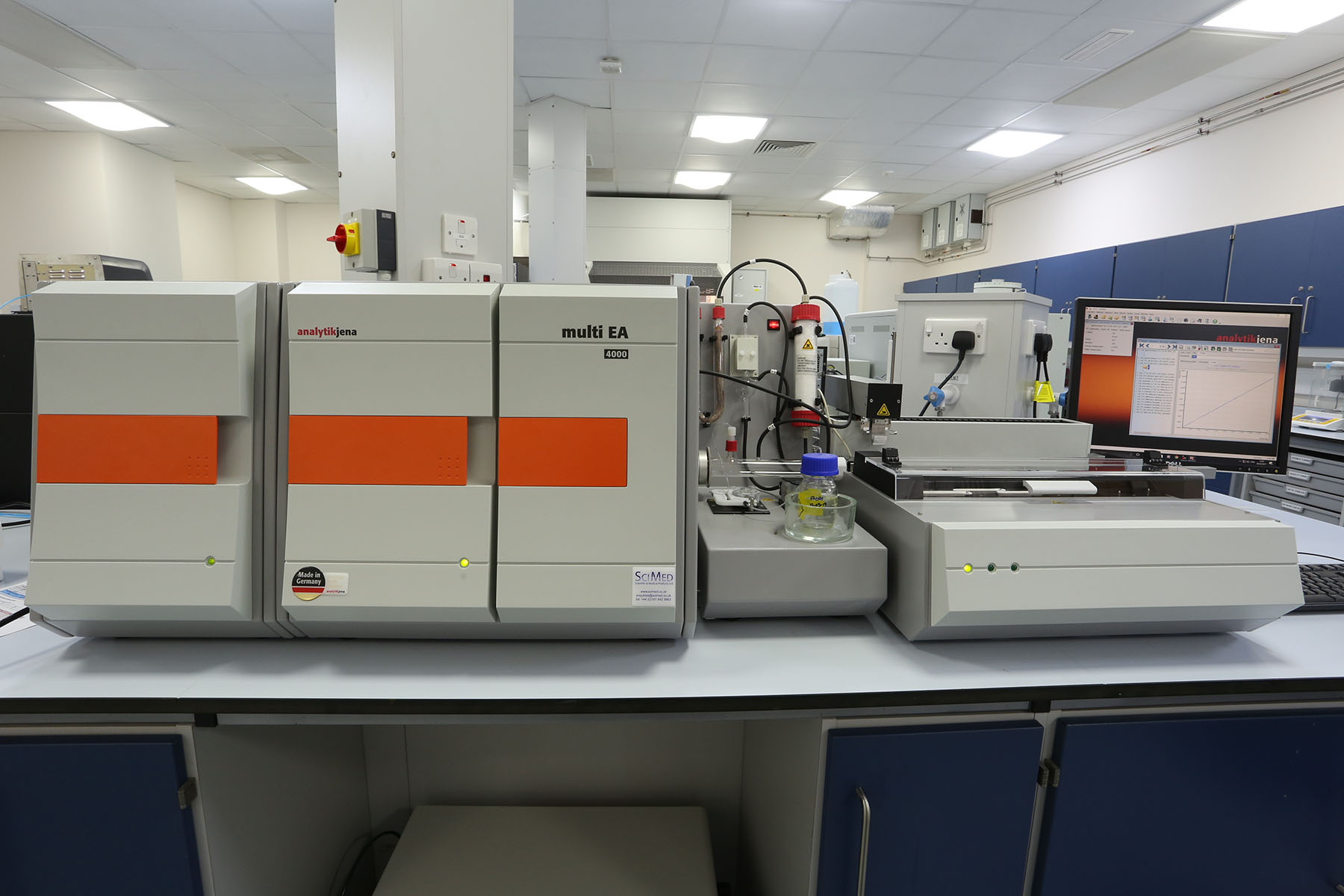
Shimadzu TOC (Total Organic Carbon)-L/TNM (Total Nitrogen Module)-L Analyser
This TOC (Total Organic Carbon) analyser uses a high temperature catalytic oxidation method in order to determine TC (Total Carbon), IC (Inorganic Carbon), TOC (Total Organic Carbon) or NPOC (Non-Purgeable Organic Carbon) in aqueous samples. Samples (minimum sample size of 15 ml) are added to the analyser using a 93 position autosampler and are heated to 680°C in an oxygen-rich atmosphere in the presence of a platinum catalyst. Oxidation of the sample generates carbon dioxide which is detected by an NDIR (Non-Dispersive Infrared) detector. TN (Total Nitrogen) content is determined by thermal decomposition at 720°C. The nitrogen monoxide gas generated from the nitrogen containing compound in the sample is detected by a chemiluminescence detector. The detection limit of this instrument is 1 mg/L of carbon.
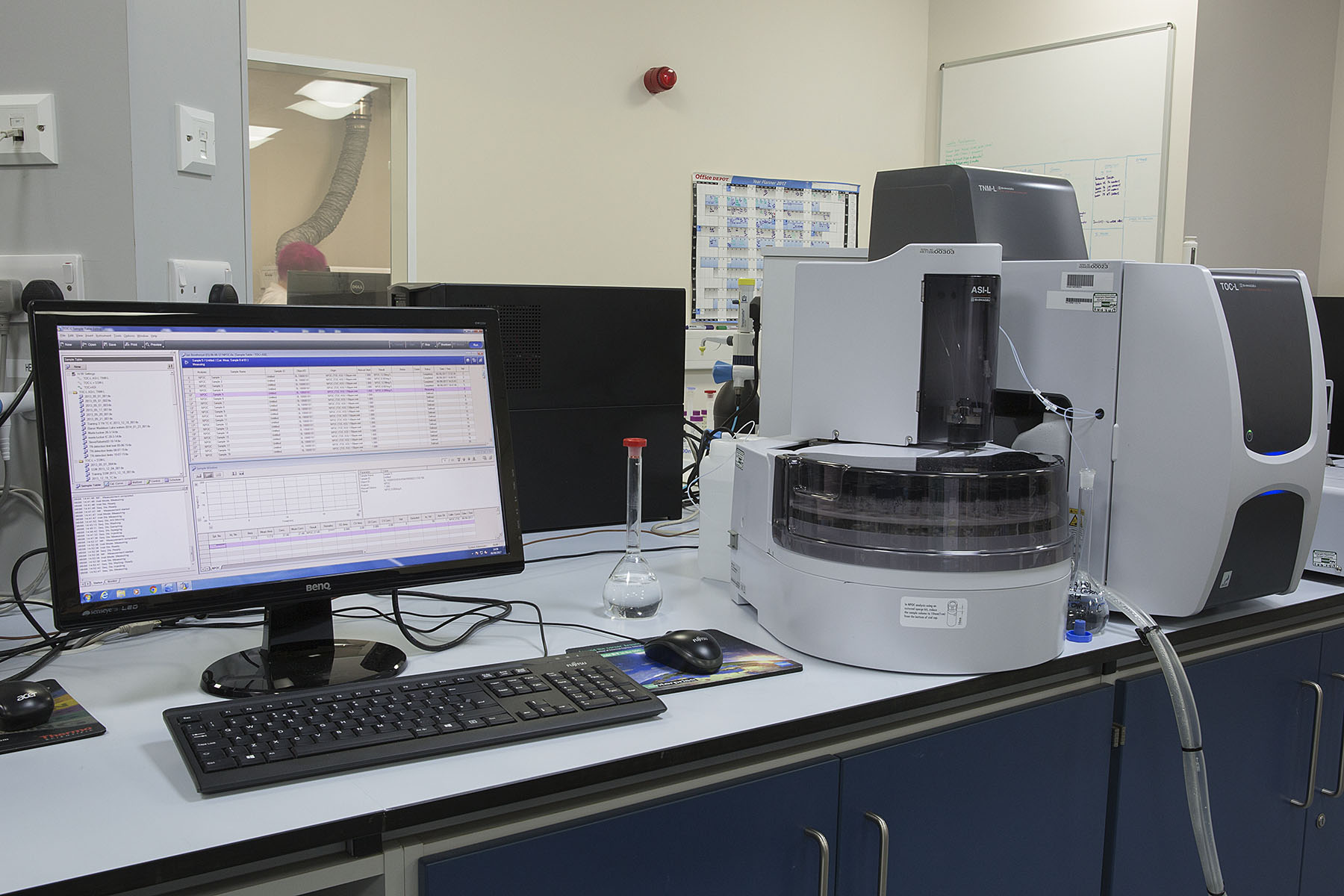
Thermo Scientific Flash 2000 Organic Elemental Analyser and NC (Nitrogen Carbon) Soil Analyser
This instrument is based on the process of dynamic flash combustion for the determination of carbon, hydrogen, nitrogen, sulphur and oxygen in solid samples. Sediment samples are freeze-dried, ball-milled and are weighed (1 – 50mg) into tin capsules.
Carbon, hydrogen, nitrogen and sulphur analysis can be carried out simultaneously using the same combustion reactor. The samples are dropped one by one into the instrument’s combustion reactor by an autosampler. The samples combust at temperatures of approximately 950°C in the presence of a small volume of oxygen in order to convert the sample into elemental gases. The gases then flow through a gas chromatographic separation column, where they are separated and are detected sequentially by a thermal conductivity detector. For oxygen, samples are dropped in to a pyrolysis reactor (heated to a temperature slightly above 1060°C) and the resulting gases flow through a gas chromatographic separation column before being sequentially detected by a thermal conductivity detector. In order to increase the sensitivity of sulphur determinations a Flame Photometric Detector (FPD 112) is used in conjunction with the Flash 2000. This instrument has a detection limit of 0.5%.
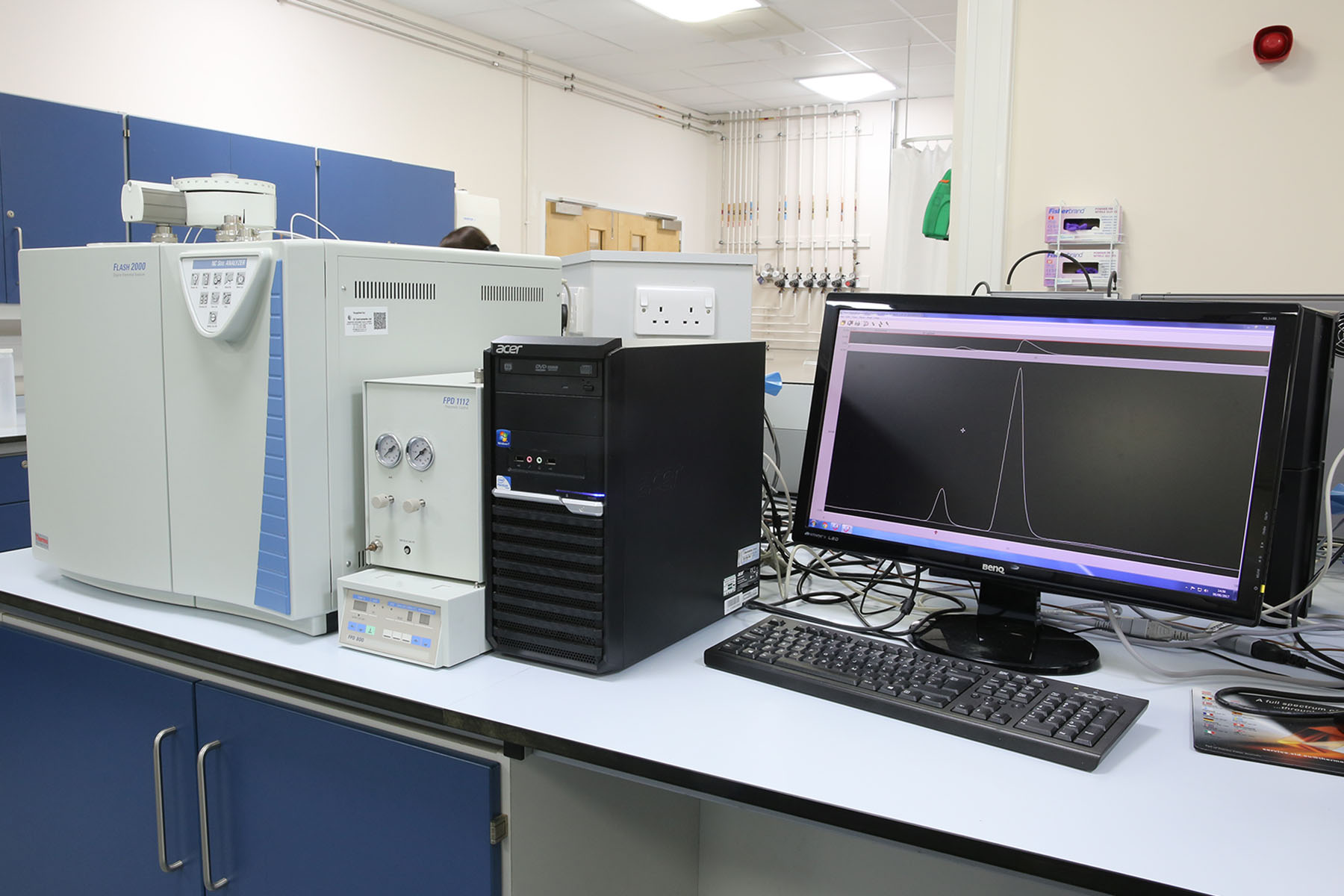
Chromatography and Spectrometry
Agilent Technologies 5100 ICP-OES (Inductively Coupled Plasma Optical Emission Spectrometer)
This Inductively Coupled Plasma Optical Emission Spectrometer (ICP-OES) is used for elemental determinations in liquid samples (10-15ml; waters, soil / sediment extracts or digests). Depending on the nature of the sample, filtered liquid samples can be run directly, acidified or digested with acid before analysis. This instrument combines a high temperature inductively coupled plasma source with an optical emission spectrometer, and is capable of measuring most of the elements in the periodic table. Using an autosampler, samples are introduced into argon plasma as aerosol droplets. The particles within the aerosol are dried, atomised, ionised, excited and relaxed. Using a diffraction grating, the light emitted from the plasma is separated into its discrete component wavelengths which are detected using a Charge Coupled Device (CCD). Individual elements can be identified as they each have distinct sets of emission wavelengths. A calibration graph is constructed so that the concentration of each element in the sample can be calculated. The instrument is fitted with a Dichroic Spectral Combiner (DSC) that enables synchronous radial and axial measurements. This instrument is advantageous as many elements can be analysed in one run using a single sample aliquot and has the option of a semi-quantitative scan method which offers a generalised look at the overall sample composition. In order to find out which elements can be measured by ICP-OES please click here.
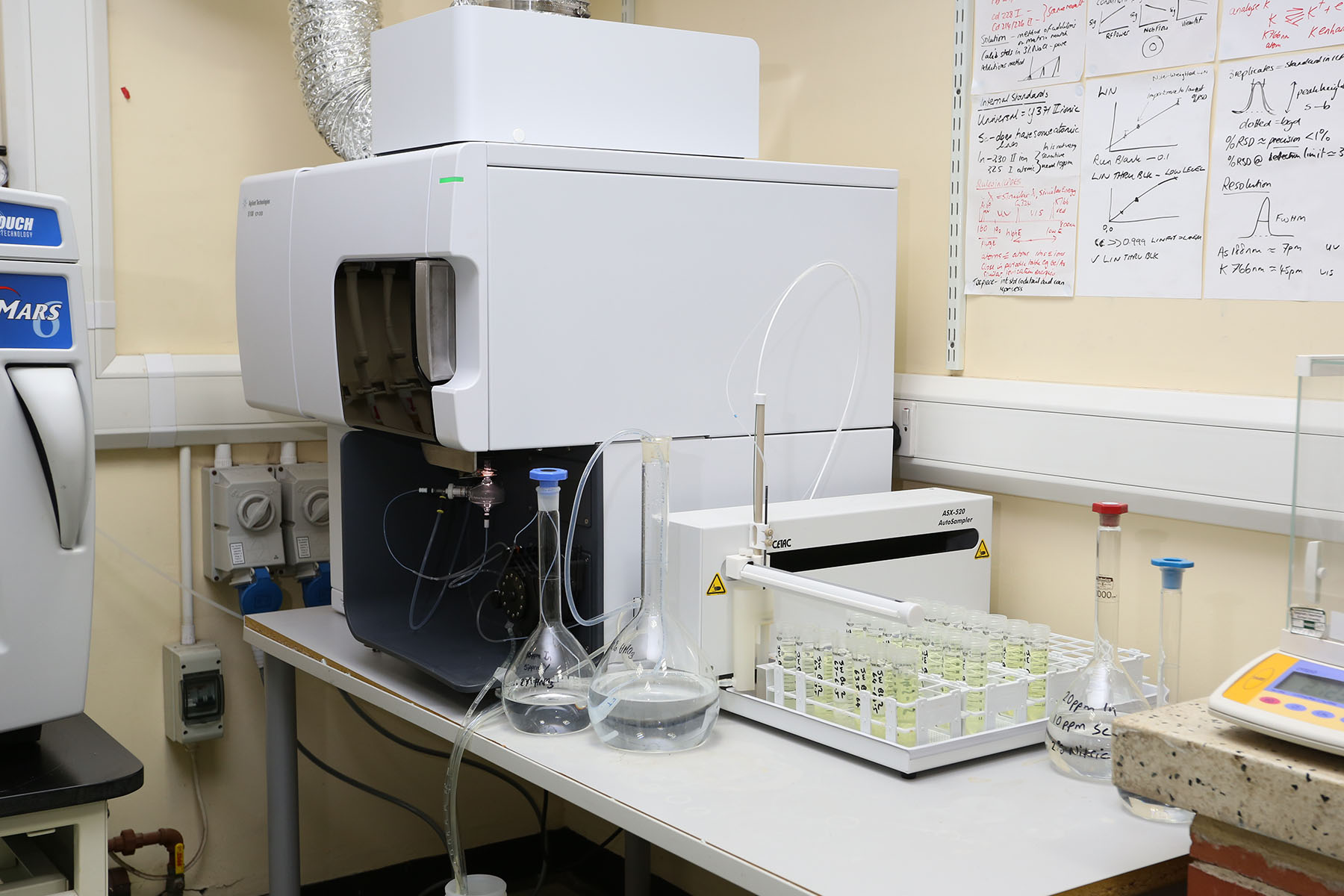
Agilent Technologies 7900 ICP-MS (Inductively Coupled Plasma - Mass Spectrometer)
This Inductively Coupled Plasma Mass Spectrometer (ICP-MS) is used for elemental determinations in liquid samples (5ml minimum depending upon metal suite; water or soil digests). Depending on the sample type, the sample may need to be filtered, acidified or digested with acid before analysis. This instrument combines a high temperature inductively coupled plasma source with a mass spectrometer, and is capable of measuring most of the elements in the periodic table. Samples are introduced into argon plasma as aerosol droplets. The plasma dries the aerosol (sample), dissociates the molecules and then removes an electron giving an excess of singly charged ions. These ions are directed into the single quadrupole mass spectrometer and the exiting beam of ions is detected electronically. This instrument is housed in a Class 1000 booth which is fully climate (temperature and relative humidity) and particulate controlled. This instrument is used preferentially over the Inductively Coupled Plasma Optical Emission Spectrometer, Flame Atomic Absorption Spectrometer and Graphite Furnace Atomic Absorption Spectrometer if lower detection limits are needed, although this depends greatly on the interferences present in the sample matrix. Isotopic or speciation analysis is possible depending upon elements of interest. In order to find out which elements can be measured by ICP-MS please click here.
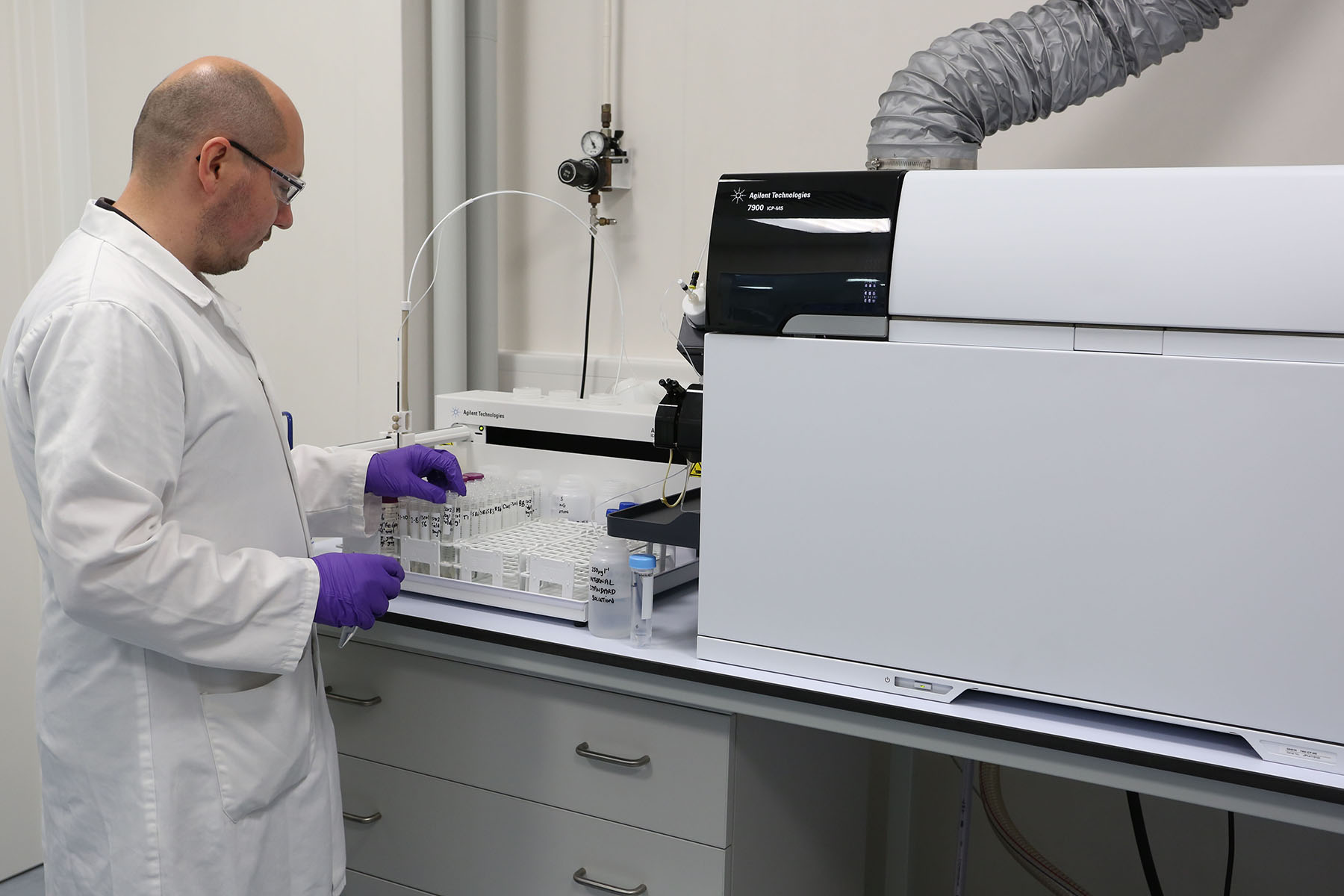
Thermo Scientific Dionex ICS 2100 (Ion Chromatography System)
The Dionex ICS 2100 is used to measure concentrations of major anions (e.g. chloride) and major cations (e.g. sodium) in water samples. The injected sample is transported through a chromatographic column by a liquid eluent, and ions in the sample are adsorbed by the column or the eluent to different extents and start to separate out. Each ionic species is identified from the retention time, the time it takes to pass through the column. Once separated each ion passes to a conductivity detector and a peak is produced on a chromatogram. A calibration graph is then used in conjunction with peak area to determine the concentration of each ionic species. Water samples should be filtered (0.2 micron) prior to analysis to remove sediment, particulate matter and to limit the potential of microbial alteration before the sample is run. Required sample size is 2-10ml and the instrument detects anions and cations at a ppm level.
Ions that can be measured by ion chromatography (by electrochemical detection)
|
Anions |
Cations |
|
Bromide (Br-) |
Ammonium (NH4+) |
|
Chloride (Cl-) |
Calcium (Ca2+) |
|
Fluoride (F-) |
Lithium (Li+) |
|
Nitrate (NO3-) |
Magnesium (Mg2+) |
|
Nitrite (NO2-) |
Potassium (K+) |
|
Phosphate (PO43-) |
Sodium (Na+) |
|
Sulphate (SO43-) |
Strontium (Sr2+)* |
Note: Nitrate and Nitrite can also be measured by UV-vis as well as by electrochemical detection)
* Strontium is better measured by ICP-OES or ICP-MS unless high levels are present in the sample.
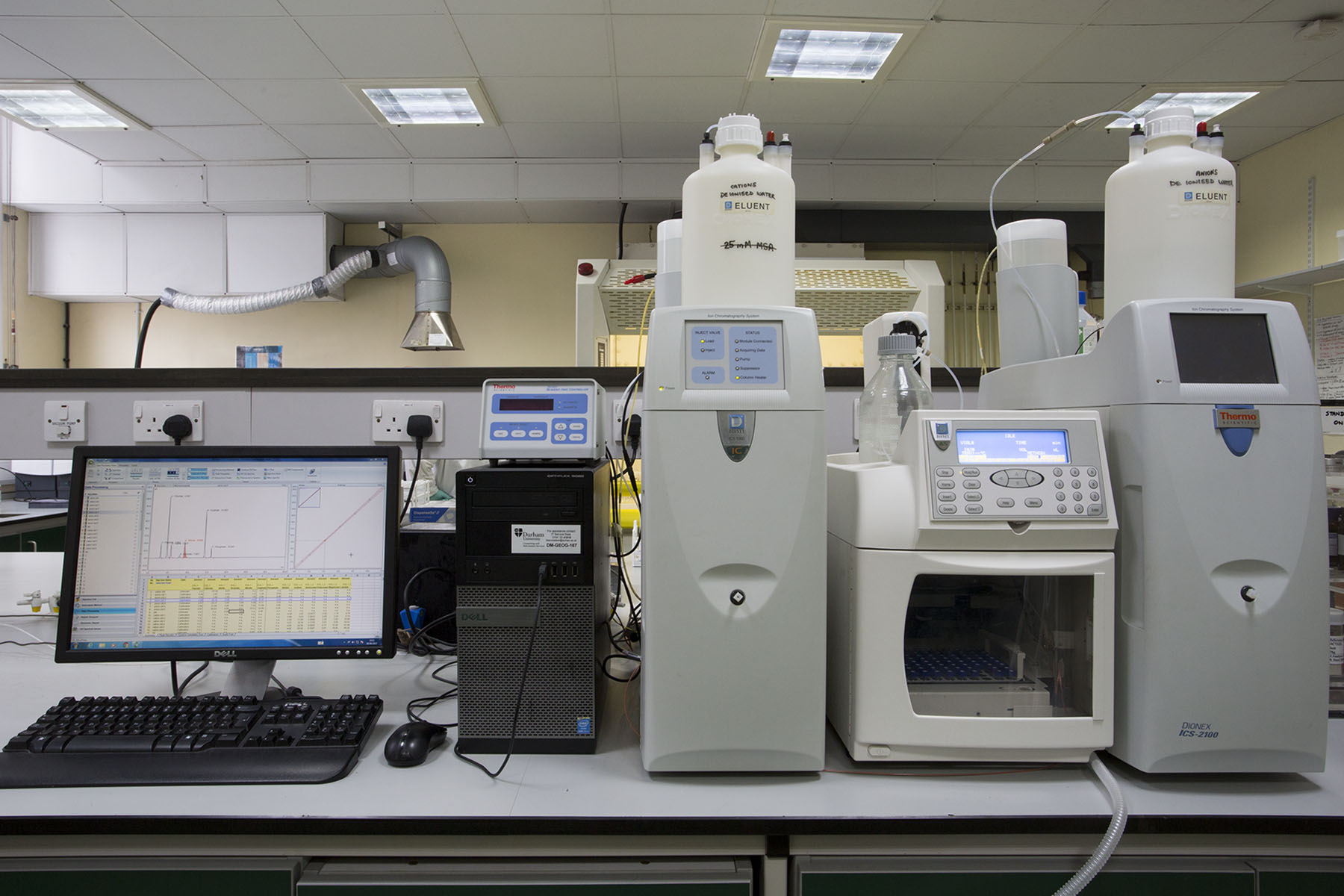
Thermo Finnigan Trace GC (Gas Chromatograph) Ultra and DSQ (Dual Stage Quadrupole) MS (Mass Spectrometer) with CDS 5150 Pyroprobe
This Gas Chromatograph – Mass Spectrometer (GC-MS) pyroprobe system allows complex mixtures of chemicals to be separated, identified and quantified. Freeze-dried and homogenised samples (e.g. soils, sediments) are weighed into silica vials and are heated to high temperatures in an inert gas, breaking apart organic compounds that are present. A GC column separates these organic fragments depending upon their chemical behaviour. Once in the MS, the fragments are ionised and detected. This produces a fragmentation pattern which can be used to both identify the original compounds present and to highlight any differences in the relative composition of the individual components within a sample.

Thermo Scientific ISQ LT Single Quadrupole MS (Mass Spectrometer) and Trace 1310 GC (Gas Chromatograph) with PTV (Programmed Temperature Vaporising) injector
This Gas Chromatography – Mass Spectrometer (GC-MS) allows complex mixtures of chemicals to be separated, identified and quantified. Organic materials in samples (e.g. soils, sediments and waters) need to be solvent extracted prior to analysis. The extracted sample is injected into the Trace 1310 GC, where it is vaporised and swept in to a chromatic column by the carrier gas (helium). The compounds in the sample are then separated by their interaction with the column coating and the carrier gas. Compounds exit the column and enter the MS where they are broken into various charged fragments by electron impact ionisation in a heated ion source. These fragments are then separated in the quadrupole filter based on their mass to charge ratio before being detected. The fragmentation patterns can be used to identify individual compounds when compared against a known reference library.
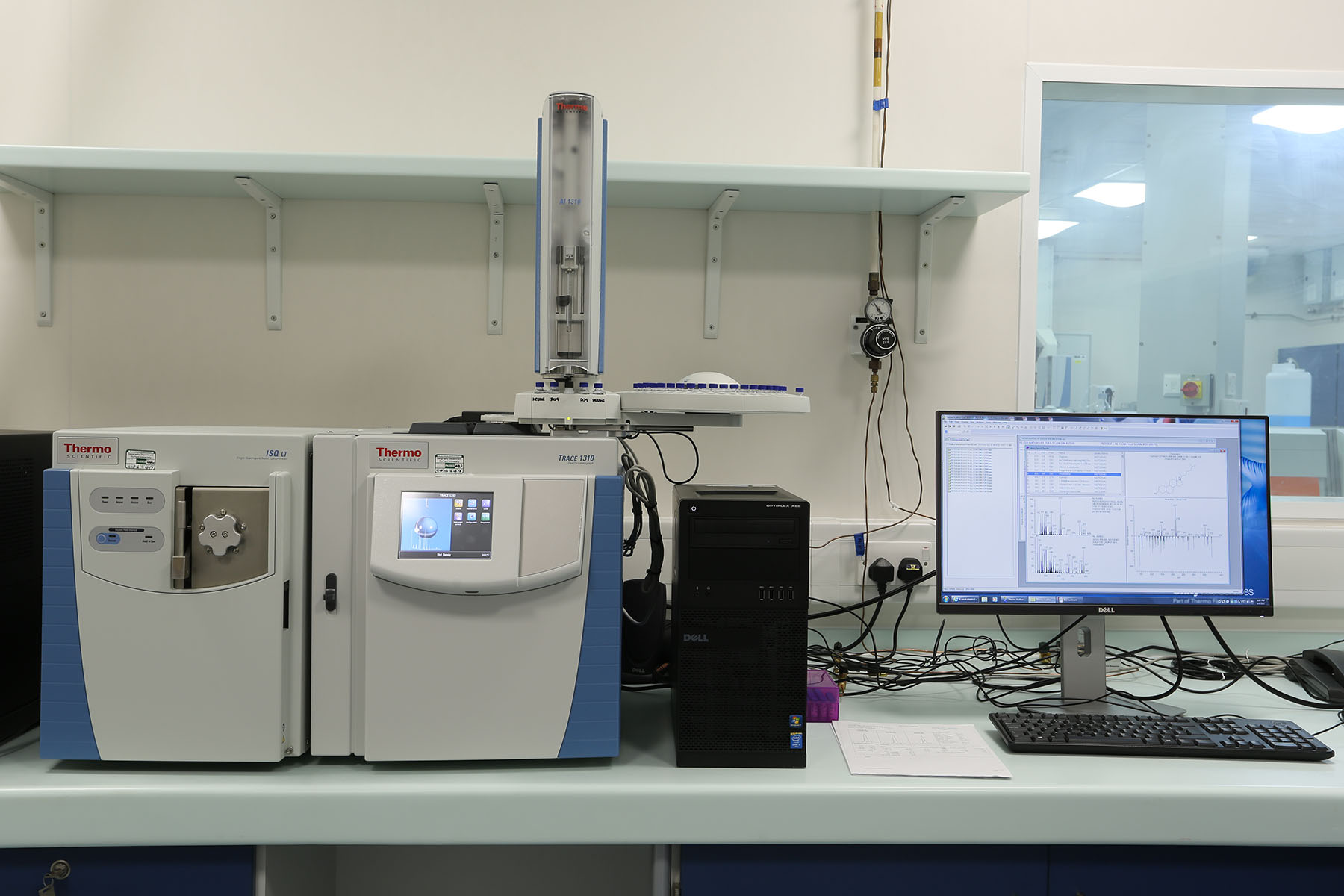
Thermo Scientific ISQ Single Quadrupole MS (Mass Spectrometer) and Trace 1310 GC (Gas Chromatograph) with PTV (Programmed Temperature Vaporising) Injector and CI (Chemical Ionisation) Reaction Gas Manifold
This Gas Chromatography – Mass Spectrometer (GC-MS) is used in a similar way to a standard GC-MS but uses a different type of ionisation called Chemical Ionisation (CI). This lower energy form of ionisation results in a relatively large abundance of charged molecular ions or charged molecular adducts, without the fragmentation typical of electron impact ionisation. This gives much better sensitivity and selectivity when the molecular structure of the compound of interest is known. Not all compounds are susceptible to chemical ionisation and since only the charged molecular ion (or charged molecular adduct) are formed it is not possible to use a library search to confirm the identity of the compound in a chromatogram. This system is currently linked to three reaction gases (methane, ammonia and isobutene) via an inlet manifold.
Thermo Scientific Trace 1310 GC (Gas Chromatograph) with Dual FID (Flame Ionisation Detector) , SSL (Split / Splitless) Injectors and Autosamplers (Gemini Configuration)
This Gas Chromatography (GC) system allows complex mixtures of chemicals to be separated, identified (by retention time) and quantified. Organic materials in samples (e.g. soils, sediments and waters) need to be solvent extracted prior to analysis. The extracted sample is injected into the Trace 1310 GC, where it is vaporised and swept in to a chromatic column by the carrier gas (helium). The compounds in the sample are then separated by their interaction with the column coating and the carrier gas. The concentrations of organic species can be determined by reference to a known calibration standard. The system is set up with dual SSL (Split / Splitless) injectors, FIDs (Flame Ionisation Detectors), and autosamplers to allow simultaneous injection of samples running the same temperature program.
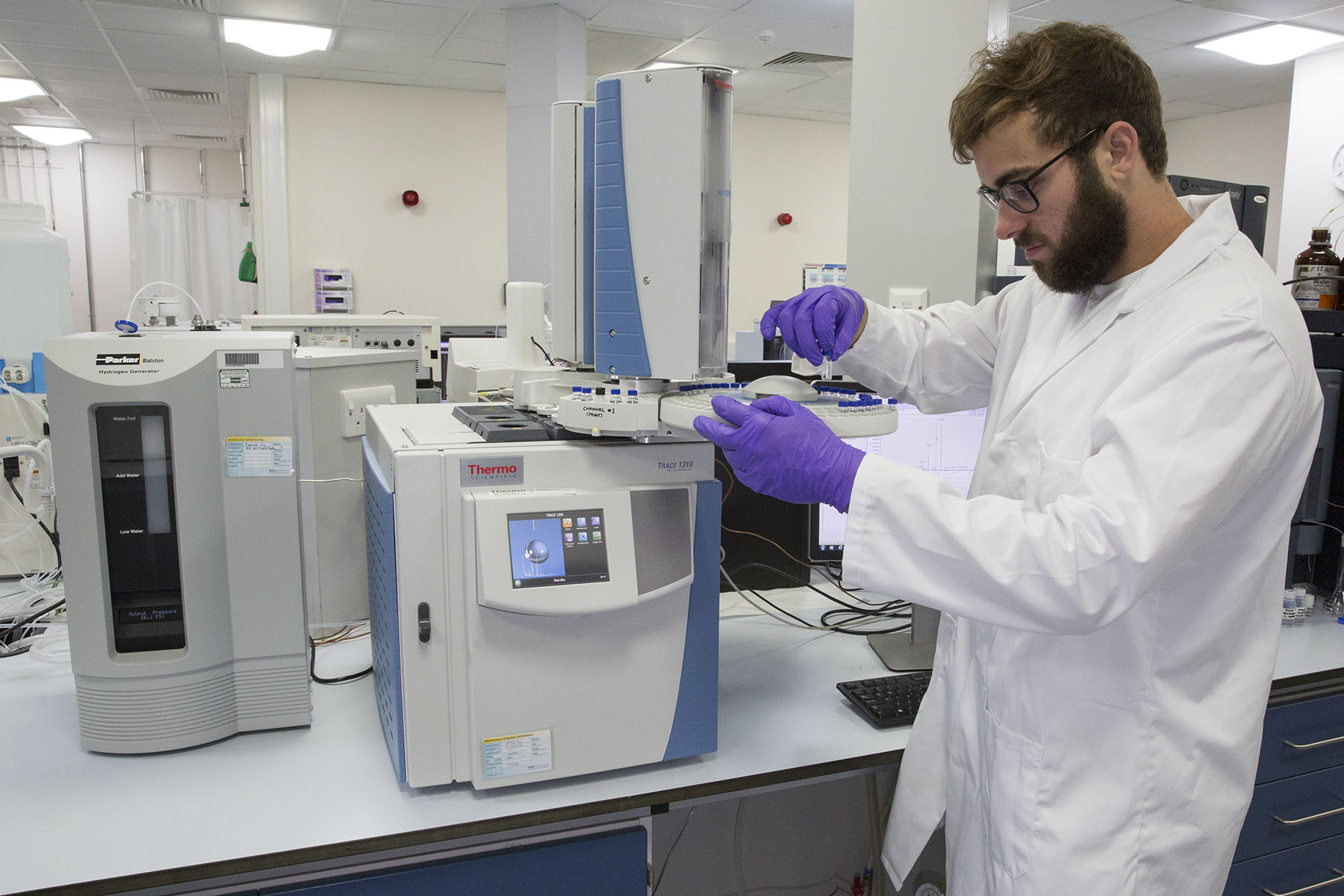
Thermo Scientific GC-IRMS (Gas Chromatograph Delta V Plus Isotope Ratio Mass Spectrometer)
This instruments measures variations in abundance of light element isotopic ratios (13C/12C, 18O/16O and D/1H) of organic compounds. Organic materials in samples (e.g. soils, sediments) need to be solvent extracted prior to analysis. The extracted sample is injected into the Gas Chromatograph (GC) where it is vaporised and swept in to a chromatic column by the carrier gas (helium). The compounds in the sample are then separated by their interaction with the column coating and the carrier gas. The sample elutes from the GC column and enters a combustion or reduction reactor where it is converted into a simple gas species. Gas molecules enter the magnetic sector of the mass spectrometer where they are ionised, focussed, and accelerated by a magnetic field. The magnetic field determines the trajectory of the ions, and sorts them based on their mass-to-charge ratio and hence isotopic abundance.
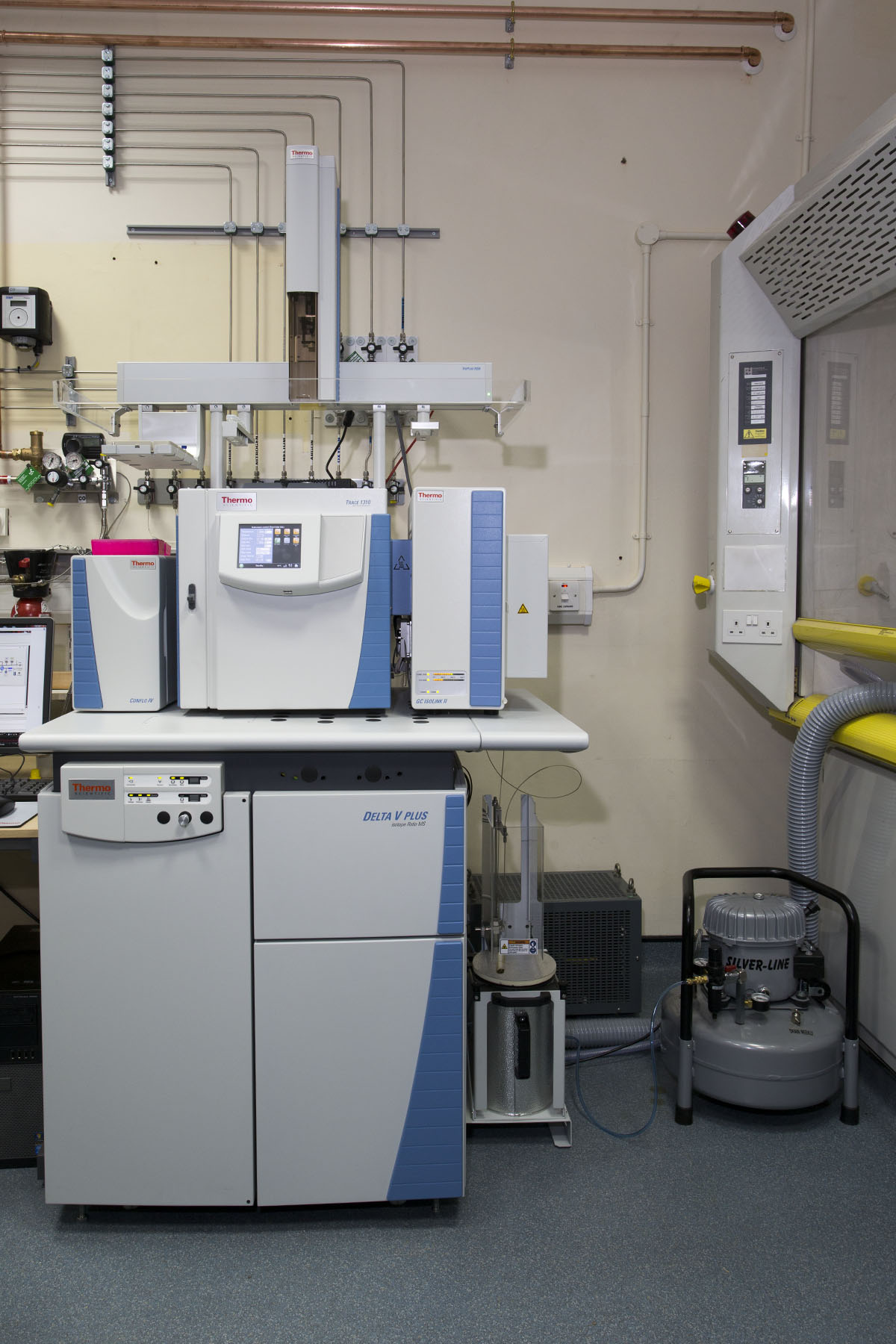
Thermo Ultimate 3000 HPLC (High Performance Liquid Chromatography) Pump and Single Channel Variable Wavelength Detector
This liquid chromatography system allows complex mixtures of organic chemicals to be separated, identified (by retention time) and quantified. Organic materials in samples (e.g. soils, sediments and waters) need to be solvent extracted prior to analysis. The extracted sample is manually injected into the flow path of the system and passes through a chromatograph column where it is separated depending upon chemical attraction to the column packing. Once separated, each ion passes into a ultraviolet / visible light detector set to a single specific wavelength which detects the compound of interest. This process is none destructive therefore the instrument can be used to both fractionate (by collecting the sample after elution through the column) and / or quantify the sample.
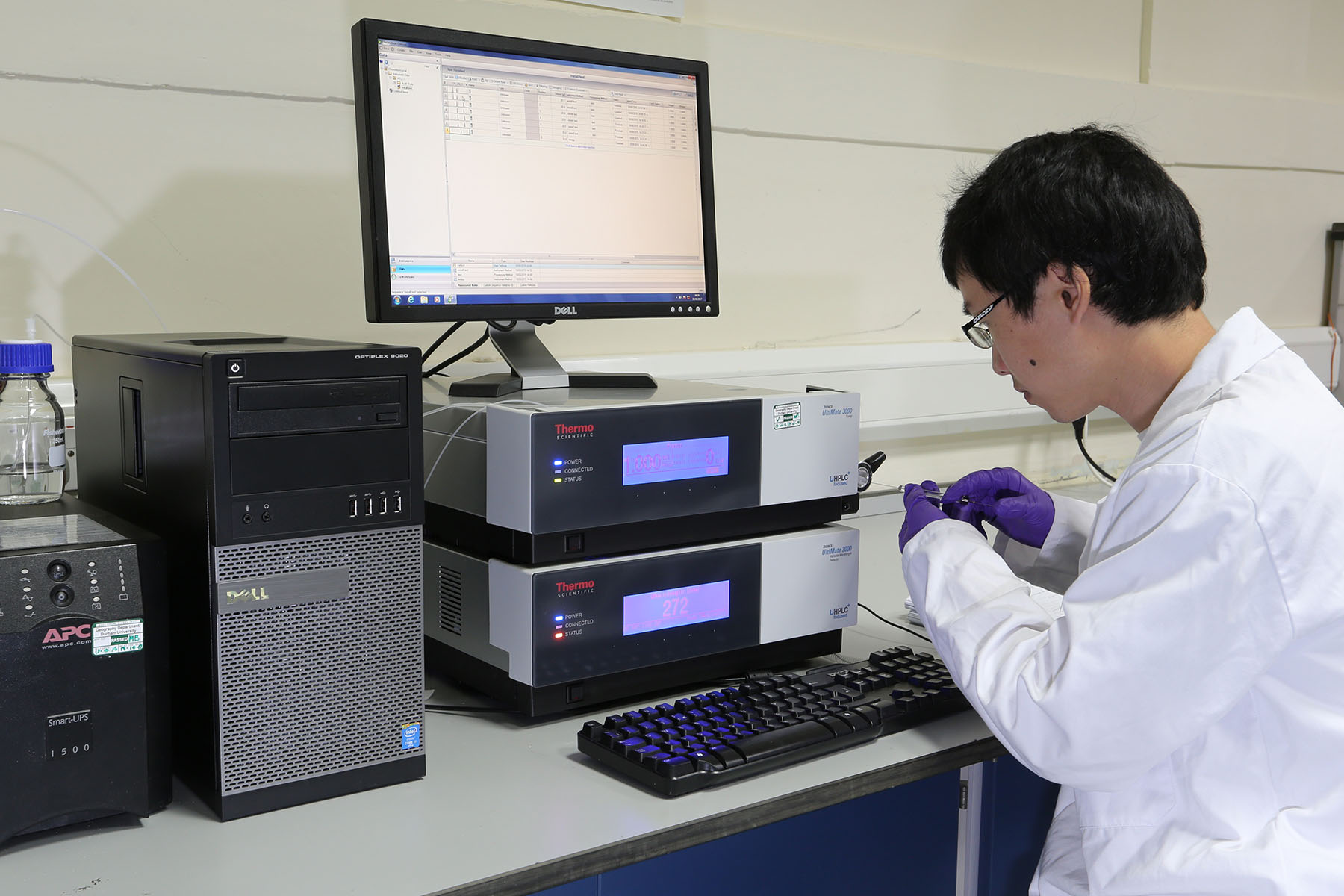
Varian Cary 50 Bio UV-Visible Spectrophotometer
This instrument measures the absorption of visible and ultraviolet light by chemicals in a liquid sample. The compounds present absorb light of a specific wavelength depending upon their structure and since this is dependent upon concentration, a calibration graph can be constructed to quantify the amount present in a sample. Some compounds do not absorb light so a mediator chemical is sometimes used which specifically reacts with the target compound, absorbing light in the visible region of the spectrum. Since the loss of light is being measured, anything which blocks the light path will give artificially high readings so samples can only be analysed if they are free of particulate matter. This instrument can perform absorbance readings at single wavelengths, full wavelength scans and kinetic scans (change in absorbance with time).
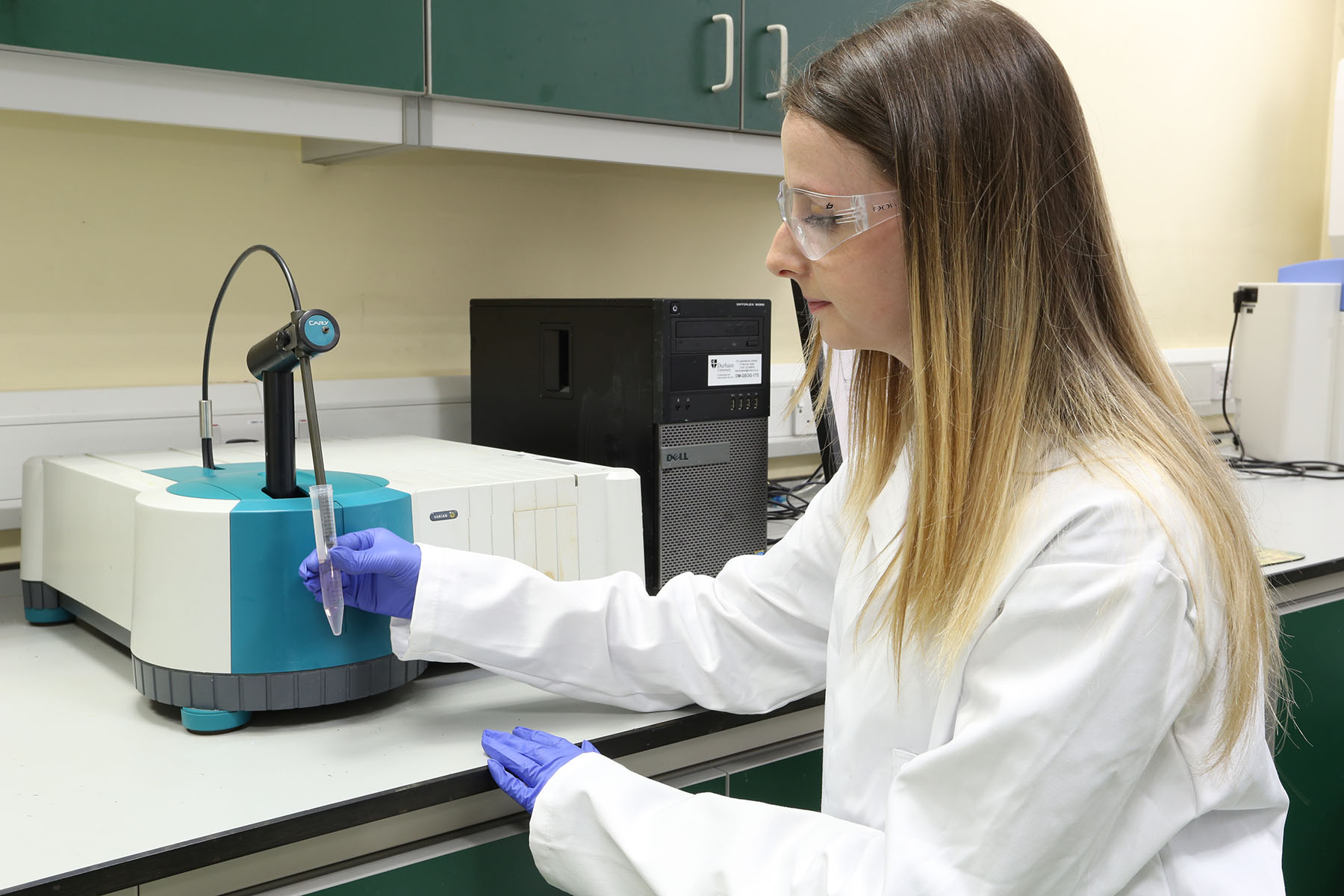
Waters Acquity UPLC (Ultra-High Performance Liquid Chromatograph) / TQ (Tandem Quadrupole) MS (Mass Spectrometer) with Fluorescence and PDA (Photo Diode Array) Detectors
This Ultra-High Performance Liquid Chromatograph (UPLC) is used to analyse organic solvent extracted samples. The sample is injected into a continuously flowing solvent, which transports the sample to the UPLC column. The column is packed with a material which separates the sample into compound bands. The compound bands are detected as they are washed out of the column by the flowing solvent. Since the characteristics of sample compounds can be diverse, we have a range of detectors (Fluorescence (FLR), Photo Diode Array (PDA) and Tandem Quadrupole Mass (TQ) detectors) and probes (Electrospray-ESI and IonSabre-APCI) which can be used individually or in combination with each other.

Radionuclide Dating
Ortec Gamma Well Detectors
These detectors are used to date soils and sediments from salt marshes and lakes using radioactive isotopes caesium-137 (137Cs), lead-210 (210Pb) and Lead-214 (a mediator for Ra-226). Caesium-137 is a man-made radionuclide created by atmospheric testing of nuclear weapons and can be used to date sediments deposited since 1950. Lead-210 is a naturally occurring radionuclide that is part of the 238U decay series and can date sediments up to 150 years old.
We have three upright well detectors which are suitable for samples with normal 210Pb concentrations. Our three J-shaped detectors are low background detectors which are ideal for samples with low 210Pb concentrations. One of these J-shaped detectors is equipped with a carbon fibre endcap, making it suitable for ultra-low background detection.
Prior to analysis sediment samples must be freeze-dried and ball-milled. Plus, dry bulk density must also be calculated for use in dating models. The samples must be placed in sealed cylindrical vials for 28 days to allow 226Ra and 214Pb to equilibrate prior to gamma analysis. The samples are inserted into a liquid nitrogen cooled germanium detector and gamma emissions from the sample are recorded using an analogue-to-digital convertor interfaced with a computer. Samples are typically counted for seven days, but can be counted for shorter time (3-4 days) if the activity is particularly high. One detector is usually assigned to each sediment core to avoid problems associated with cross calibrating detectors.
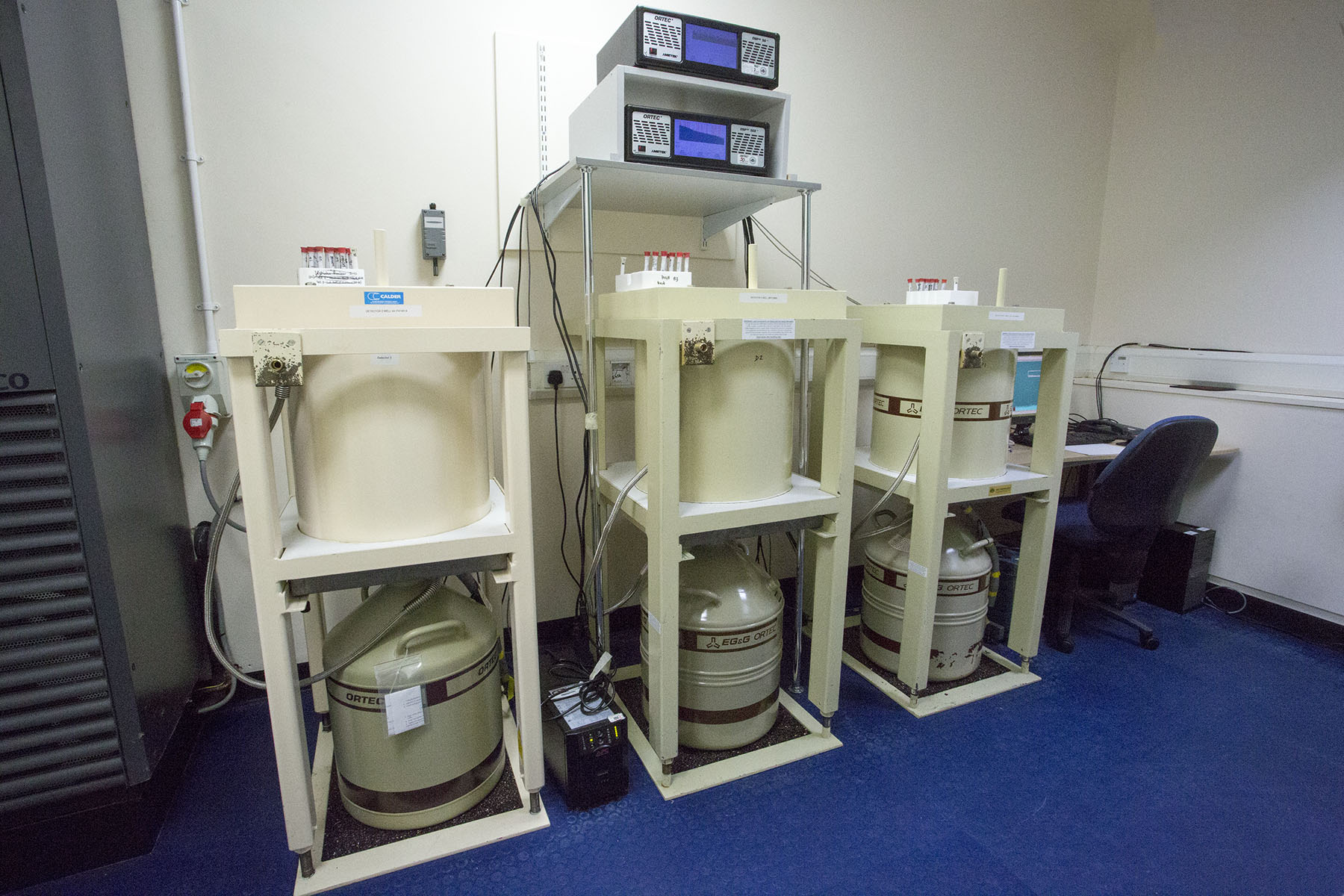
X-Ray Instruments
Bruker Tracer 5i XRF (X-ray Fluorescence)
This piece of equipment is a portable, handheld XRF analyser. It can be used in the laboratory or in the field for element determination and quantification in sediments and rocks. The sample material is excited by the bombardment of high energy x-rays generated in the rhodium x-ray tube. Different elements in the sample respond by emitting x-rays at energies characteristic of its elemental composition. This pXRF is housed in the Department of Archaeology but is available for use by Geography staff and postgraduates.
Geotek X-ray CT Core Imaging System (MSCL-XCT)
The Geotek X-ray CT core imaging system is used to collect linear digital x-ray images on whole or split cores. These images are then used to produce computed tomographic (CT) reconstructions, visualising three-dimensional structures within cores. This piece of equipment is unique, as it x-rays cores in a vertical configuration and was designed specifically for the Geography Department at Durham University. Core sections up to 1.5 m in length and 12 cm in diameter can be imaged. The x-ray source and detector positions can be adjusted in order to ensure optimal image quality and to accommodate different core diameters. The system is fully shielded and enclosed, with an interlock system that ensures that x-rays cannot be generated when the doors are open.
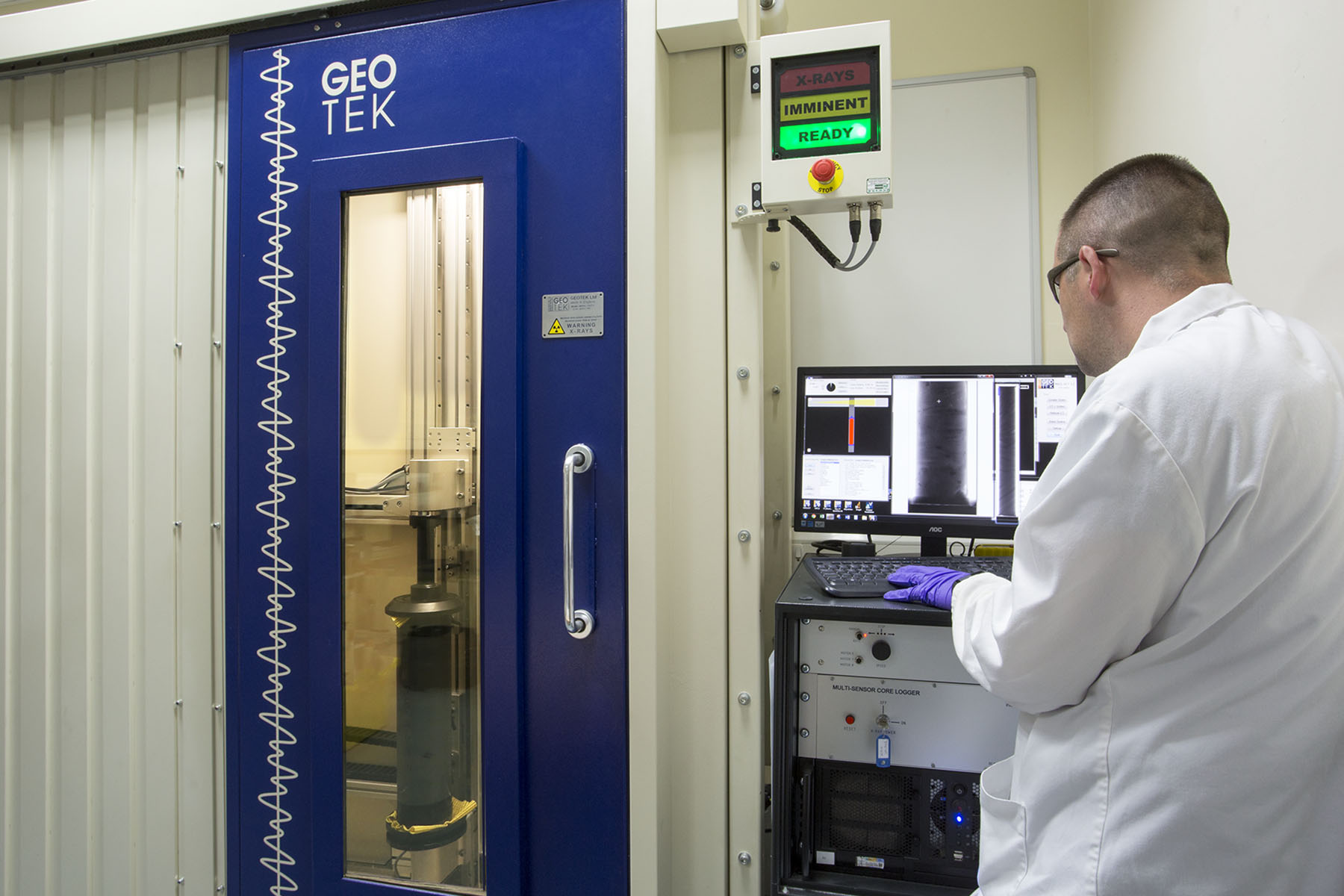
Geotek X-ray Fluorescence (MSCL-XRF)
This instrument is an integrated part of our Multi Sensor Core Logger (MSCL-S) and is used to acquire high-resolution elemental abundance data from the surface of rock cores, sediment cores and sediment slabs. It has a downcore resolution of 0.1 to 10mm and a crosscore resolution of 5, 10 or 15 mm. The sample material is excited by the bombardment of high energy x-rays generated in the rhodium x-ray tube. A wide range of elements (magnesium to uranium) can be detected at ppm levels. To improve the sensitivity of light element (e.g. magnesium, aluminium and silicon) measurements the measurement cell is flushed with helium. The system is fully shielded and enclosed, with an interlock system that ensures that x-rays cannot be generated when the doors are open.
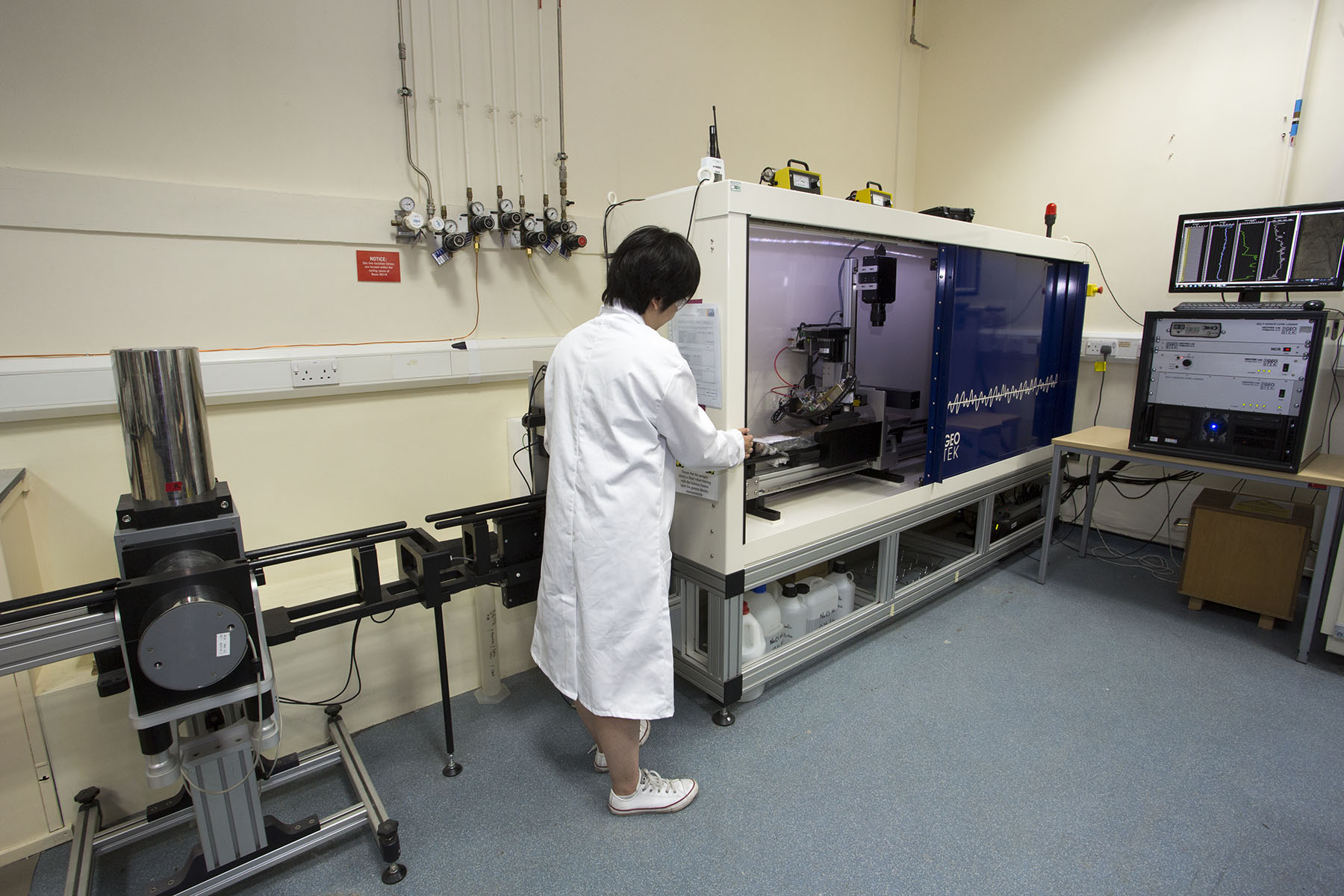
Niton pXRF (portable X-Ray Fluorescence) (XL3T 985 He Ultra)
This piece of equipment is a portable, handheld X-ray Fluorescence (XRF) analyser. It can be used in the laboratory or in the field for element determination and quantification in sediments and rocks. The sample material is excited by the bombardment of high energy x-rays generated in the silver x-ray tube. Different elements in the sample respond by emitting x-rays at energies characteristic of its elemental composition. With this portable XRF there is an option to use a helium flush in order to improve analysis of lighter elements.
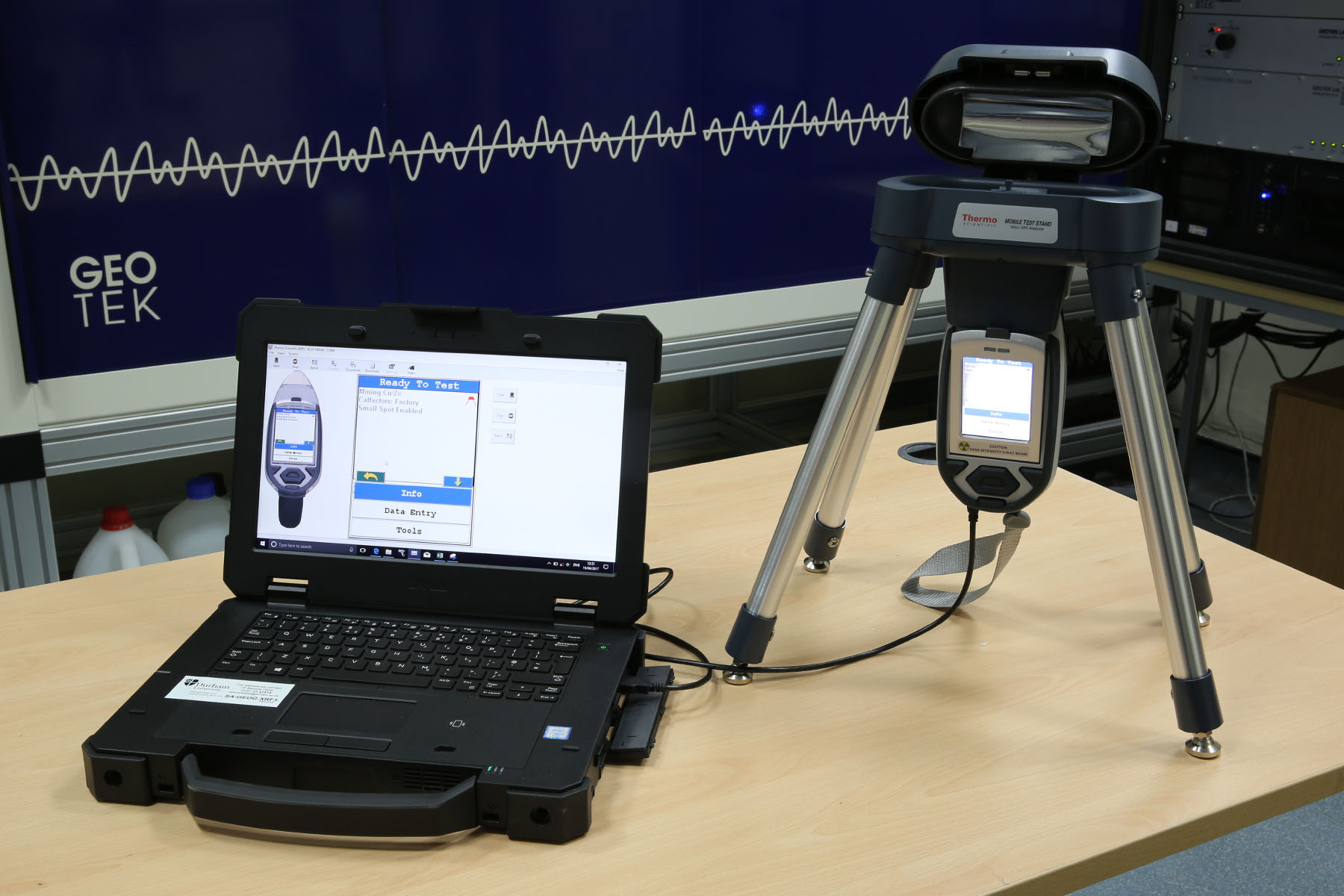
Particle Characterisation
Beckman Coulter LS 13 320 Laser Diffraction Particle Size Analysers
We have two Beckman Coulter LS 13 320 Laser Diffraction Particle Size Analysers in our Laithwaite Landslide Laboratory, one designated for teaching and the other for research. These instruments use laser diffraction to measure the size distribution of particles in the range 0.4 µm to 2000 µm. Laser diffraction works by measuring the patterns of scattered light produced when a laser beam passes through a dispersed particulate sample. This instrument also contains a PIDS (Polarisation Intensity Differential Scattering) detection system, which uses the scattering of polarised light to measure particles in the range 0.04 microns to 0.4 microns. Sediment samples must be prepared prior to analysis, specifically organic material is removed and the particles disaggregated. Samples are introduced into this instrument through an aqueous liquid sample module.
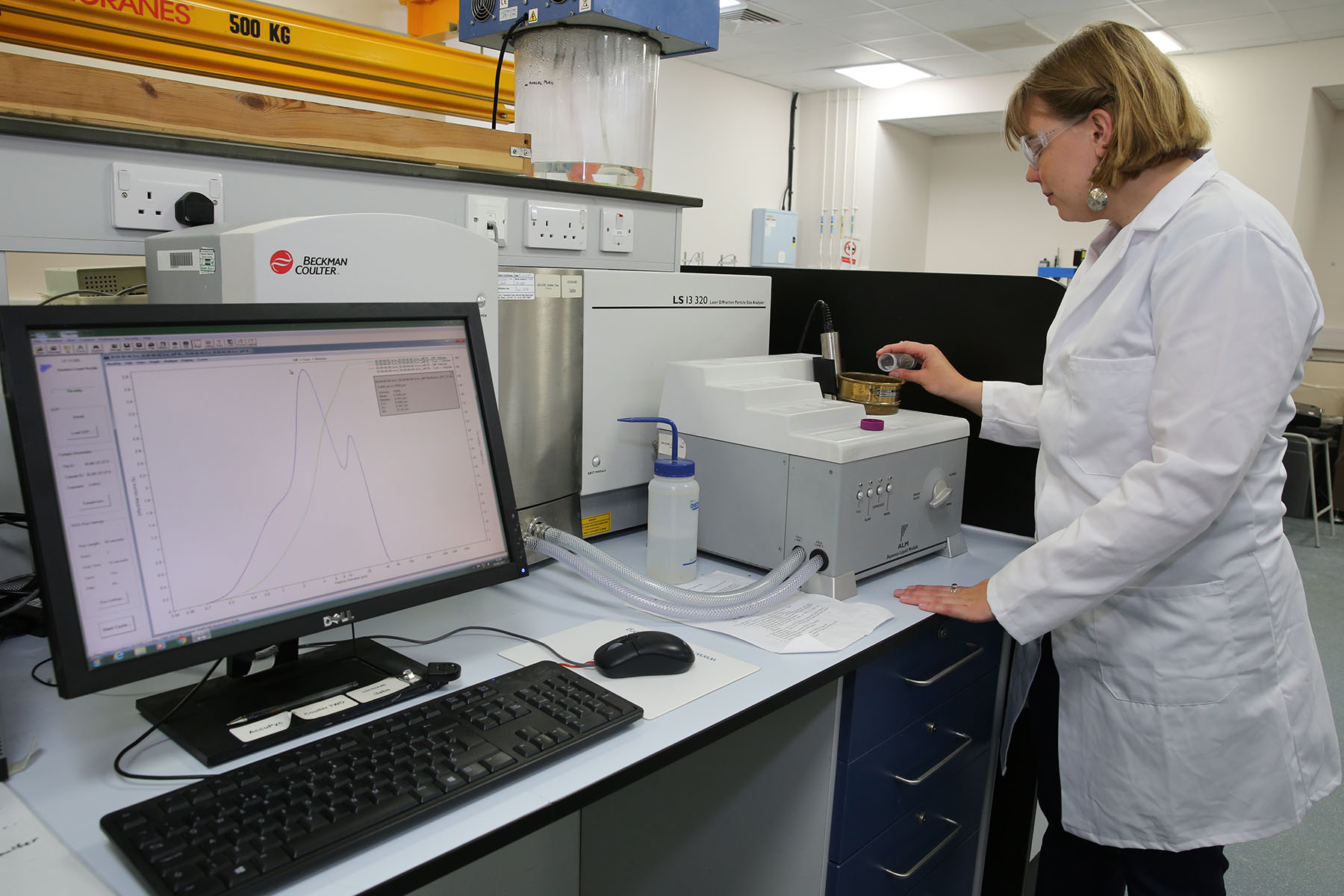
Micromeritics AccuPyc II 1340 Pycnometer
This piece of equipment is used to measure the volume and density of samples by gas displacement (nitrogen). The sample is placed in a sealed compartment of known volume which is then filled by nitrogen. The pressure in the sample compartment is recorded, the gas is then discharged into a second empty compartment and the pressure is recorded. The difference in the gas pressure in the two compartments allows the density of the sample to be calculated. Both solid (consolidated or unconsolidated) and liquid (with no significant vapour pressure) samples can be run on this instrument.

Wykeman Farrance Cone Penetrometer
The cone penetrometer is used to determine the liquid limit of a soil. This defines one of the Atterberg limits: the boundary between a plastic and fluid state of the sample. The cone penetrometer test relies on the shear strength of the sample. A standardised cone of specific mass is allowed to penetrate a wet soil paste for five seconds; the depth penetrated is used to calculate the liquid limit, according to British Standard BS1377.

Soil, Sediment and Rock Testing
Debris Flow Flume
Our bespoke debris flow modelling facility is used to investigate debris flow dynamics. The flume channel is 8m long and is accommodated in a 1m box frame, which provides strength and allows for a versatile modular channel configuration for both rigid, roughened channels and erodible channels with deformable bed and banks. The dimensions of the channel and the slope angle of the flume can be varied.

ELE Point Load Test Apparatus
This apparatus is used to determine the point load strength of a rock by compressing a sample between conical steel platens until failure occurs. An axial load is applied by a hand operated hydraulic jack and the failure load is recorded on a pressure gauge. Loads of up to 50 kN can be applied to specimens up to approximately 100 mm in diameter.
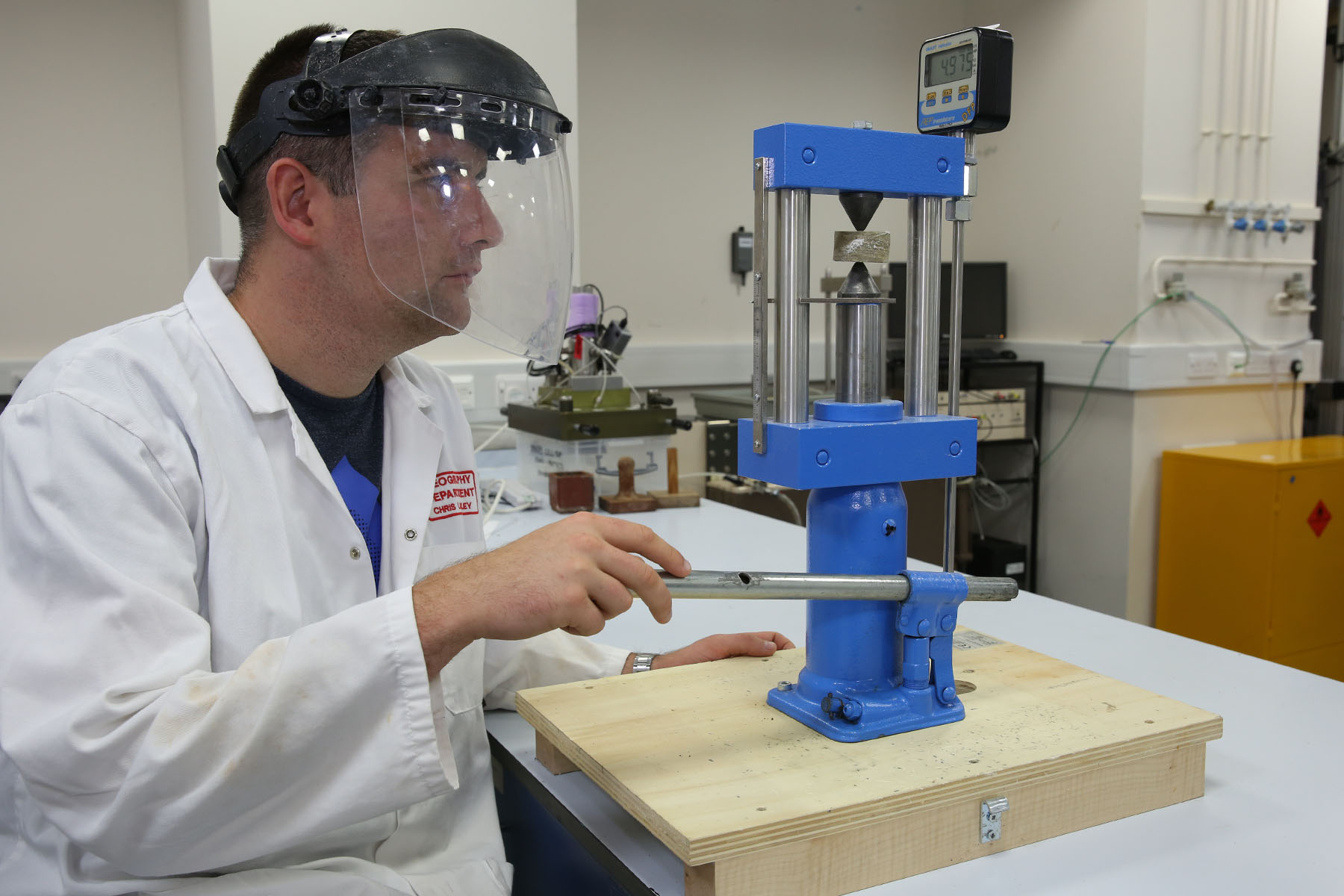
GDS Back Pressure Shearbox
This piece of equipment is used to determine the shear strength of a soil mass in a two-dimensional system. Purpose built for Durham University for landslide analysis, this Back Pressure Shearbox actively controls pore water pressure in the sample. Tests can be carried out with different moisture conditions. The sample is confined to a square metal box split horizontally at mid-height. Both undisturbed and remoulded samples can be analysed. Porous plates above and below the box allow free drainage of the sample. A vertical force is applied through a loading plate, and shear stress is gradually applied on a horizontal plane by causing the two halves of the box to move relative to each other. By carrying out tests on a set of similar specimens of the same soil under different normal stresses, the relationship between measured stress at failure and normal stress applied can be obtained. This shear box is fully computer controlled with integrated data capture.
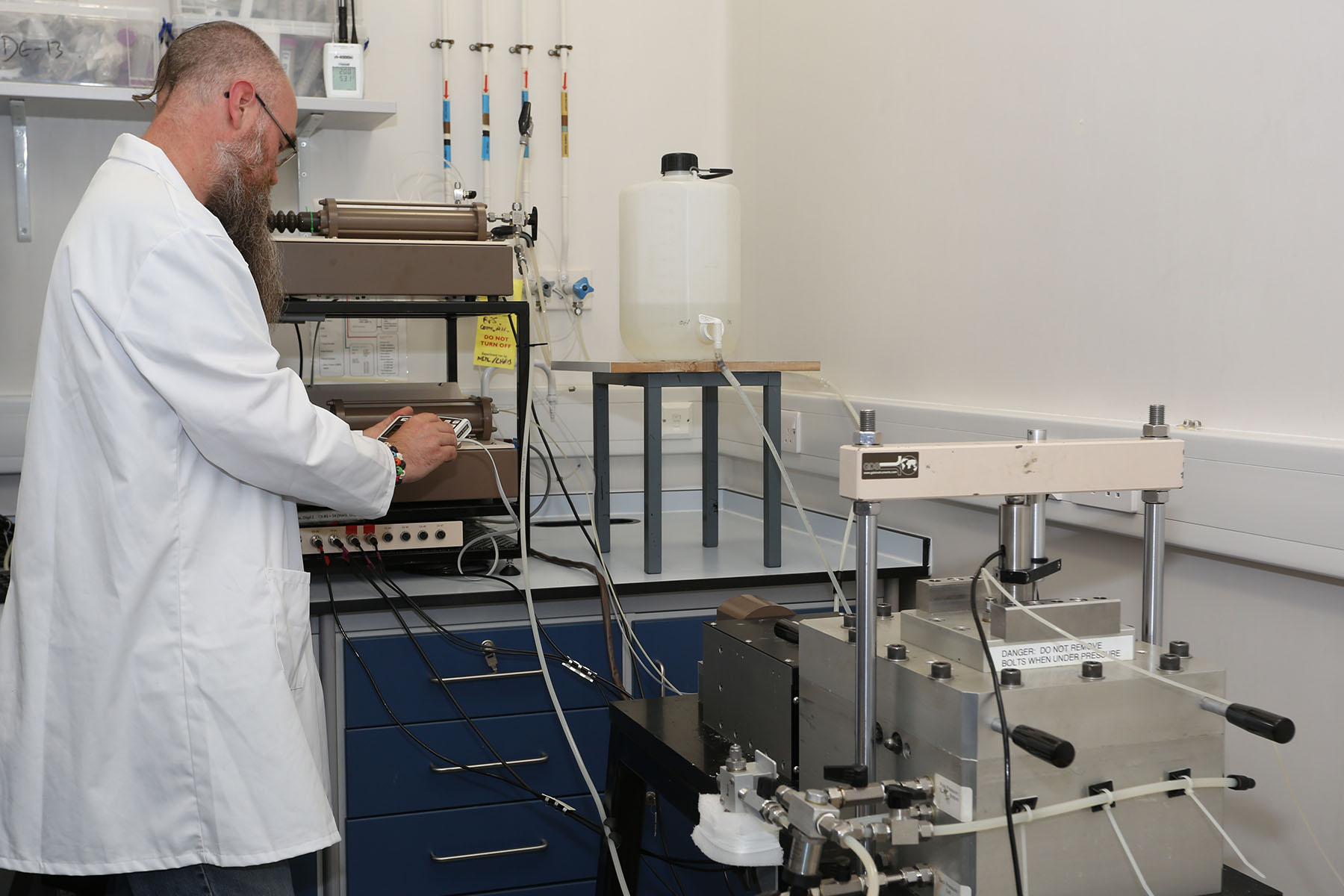
GDS Dynamic Back Pressure Shearbox
This piece of equipment is used for static and dynamic direct shear testing on soil samples in a two-dimensional system. This shearbox can control shear strain at a monotonic rate. Tests can be carried out with different moisture conditions. The sample is confined to a square metal box split horizontally at mid-height. Both undisturbed and remoulded samples can be analysed. Porous plates above and below the box allow free drainage of the sample. A vertical force is applied through a loading plate, and shear stress is gradually applied on a horizontal plane by causing the two halves of the box to move relative to each other. This device provides realistic modelling of slope stability and earthquake loading, and is capable of dynamic tests up to 5Hz. This shear box is fully computer controlled with integrated data capture.

GDS Triaxial Stress Path Cell
This triaxial stress path cell allows the shear strength and stiffness of soil to be determined. In this instrument the sample drainage can be controlled and pore water pressure measurements can be taken. A cylindrical specimen, having an approximate 2:1 height to diameter ratio, is sealed within a rubber membrane and is saturated, consolidated and sheared. During the shear stage the sample is loaded axially. This instrument has a maximum pressure rating of 2MPa.
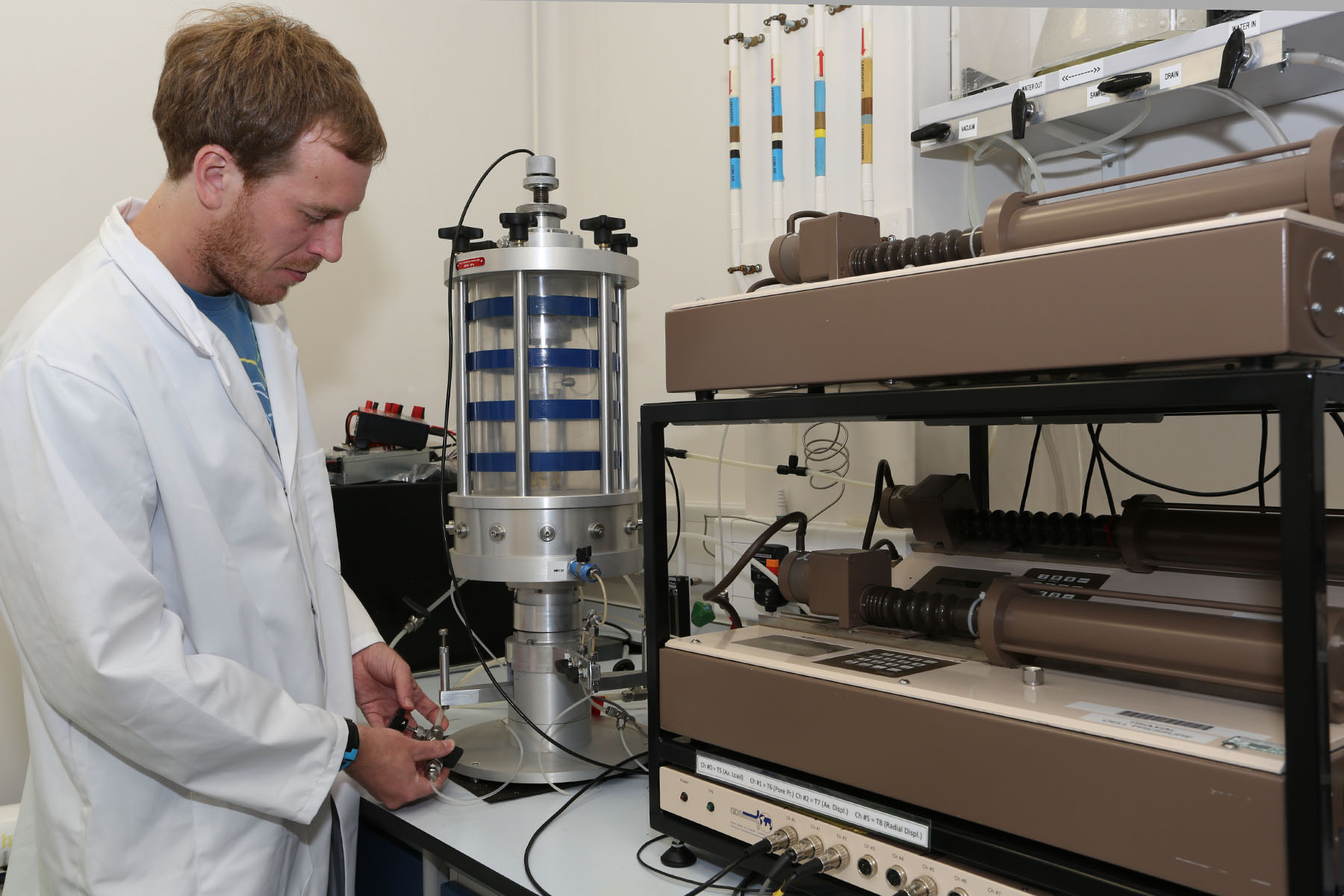
GDS VIS (Virtual Infinite Stiffness) Loading System and High Pressure Triaxial Cell
This high pressure triaxial cell is housed within a load frame, the Virtual Infinite Stiffness (VIS) loading system. This equipment is used to determine the shear strength and stiffness of solid rock samples. Samples are subject to axial loading until failure of the material occurs.
The Virtual Infinite Stiffness (VIS) loading system allows axial loading to operate as if it has infinite stiffness. The load range of the system is 400kN and the cell can achieve sample confining pressures of up to 64MPa. Samples are instrumented with Linear Variable Displacement Transducers (LVDT, which are precise to 0.1 microns) linked to a PC. Real time data can be streamed up to 50Hz, with logging rates up to 1kHz usable under certain test scenarios. Unconfined and confined tests can be conducted using this equipment.
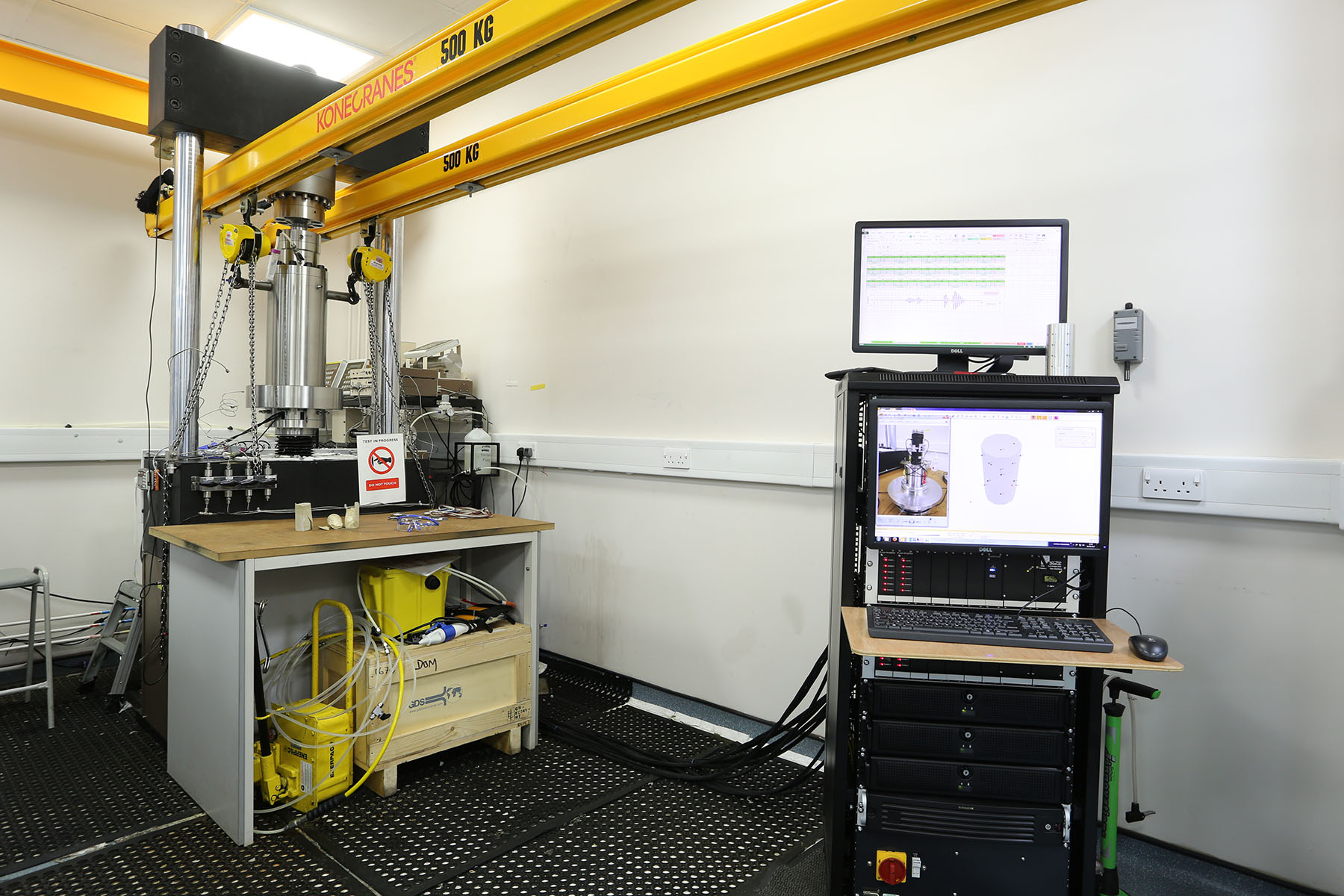
GDS AOS (Automated Oedometer System)
These oedometers are used to determine the rate and magnitude of the consolidation of a saturated or near-saturated soil or sediment. This automated system is a modern replacement for traditional hanging weight oedometers. Vertical axial loading of up to 5kN is applied to the sample by a computer controlled stepper motor. The consolidation of the sample is measured by Linear Variable Displacement Transducers (LVDT) linked directly to a PC. Prior to the experiment the sediment sample is normally saturated for at least 12 hours.

Lemmens Grindosonic
This instrument measures natural vibration frequencies in prepared rock samples through the use of non-destructive impulse excitation. A mechanical impulse is applied to the sample, which produces a mechanical vibration. The recorded vibration, along with the dimensions and mass of the test material, are used to calculate the elastic properties of the sample.

Wykeham Farrance Front Loading Oedometers
These oedometers are used to determine the rate and magnitude of the consolidation of a saturated or near-saturated soil or sediment. The sample, in the form of a disc, is restrained laterally by a steel ring and is allowed to drain freely (via porous discs at the top and bottom of the sample). The sample is subjected to discrete increments of vertical axial loading. The consolidation of the sample is measured by Linear Variable Displacement Transducers (LVDT) linked directly to a PC via a data acquisition unit. Prior to the experiment the sediment sample must be saturated for 24 hours. Up to 64kg of weight can be applied to the sample, which is equivalent to a vertical effective stress of up to 1600kPa, which is dependent on sample cross-sectional area.
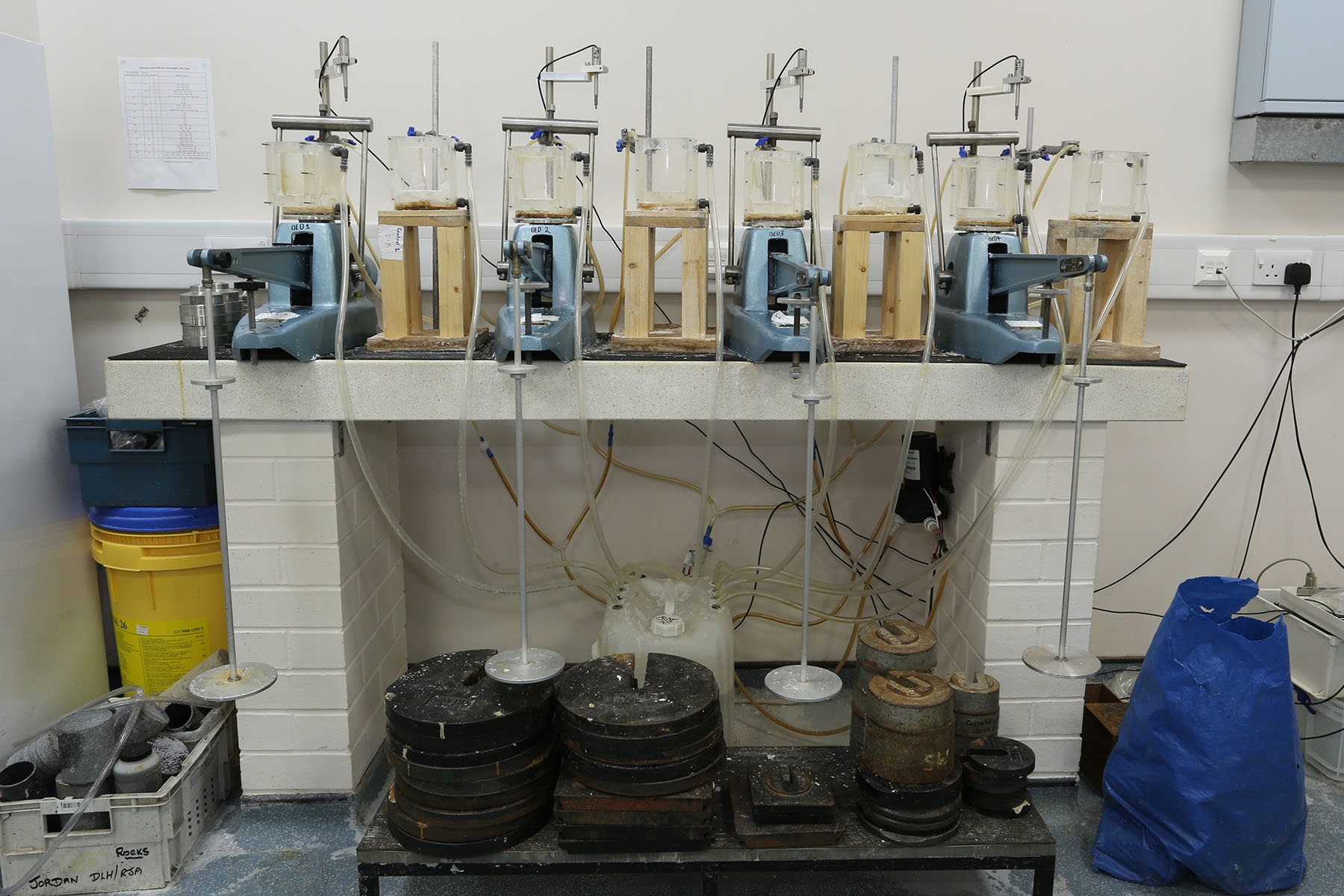
Wykeham Farrance Pneumatic Direct / Residual Shear Box Shearmatic
This equipment is used to determine the shear strength of a soil mass in a two-dimensional system. The test can be carried out with different moisture conditions; however, samples are typically saturated. The sample is confined to a square metal box split horizontally at mid-height. Both undisturbed and remoulded samples can be analysed. Porous plates above and below the box allow free drainage of the sample. A vertical force is applied through a loading plate, and shear stress is gradually applied on a horizontal plane by causing the two halves of the box to move relative to each other. By carrying out tests on a set of similar specimens of the same soil under different normal stresses, the relationship between measured stress at failure and normal stress applied can be obtained. This shear box is computer controlled with integrated data capture.

Slope Stability Testing
Landscape Analogue Model
This piece of equipment is used to establish the geometrical controls (slope length, angle and curvature) on the spatial and temporal evolution of slope failure, and to determine the surface strain on failing slopes. The analogue model material, made of liquid and solid hydrocarbons, is shaped to produce the desired slope morphology. It is placed on a platform which is uplifted to 2 m height and is then released to produce gravity induced stress. This is repeated to observe rupture propagation. A computer controlled system coordinates the platform position with a 3D imaging system in order to capture the model surface after each drop. This equipment is purpose built and is based on the design detailed in Chemenda et al. (2005).
Chemenda, A., Bouissou, S. and Bachmann, D. (2005). Three-dimensional physical modelling of deep-seated landslides: new technique and first results. Journal of Geophysical Research 110, F04004, doi: 10.1029/2004JF000264.

Core Analysis Instruments
Geotek Multi Sensor Core Logger Standard (MSCL-S)
In the department we have an automated, non-destructive Geotek Multi Sensor Core Logger (MSCL-S) which can rapidly obtain high-resolution data from terrestrial and marine cores. Our logger is equipped with a range of sensors which can make measurements on whole or split cores. The MSCL-S can measure P-wave velocity, gamma density, natural gamma, non-contact resistivity, magnetic susceptibility and X-ray fluorescence. It is also fitted with a line-scan imager. Core sections can be up to 150 cm long and 50-150 mm in diameter.
For further information on this piece of equipment please contact Dr Eleanor Ross (e.j.maddison@durham.ac.uk, 0191 334 1963).
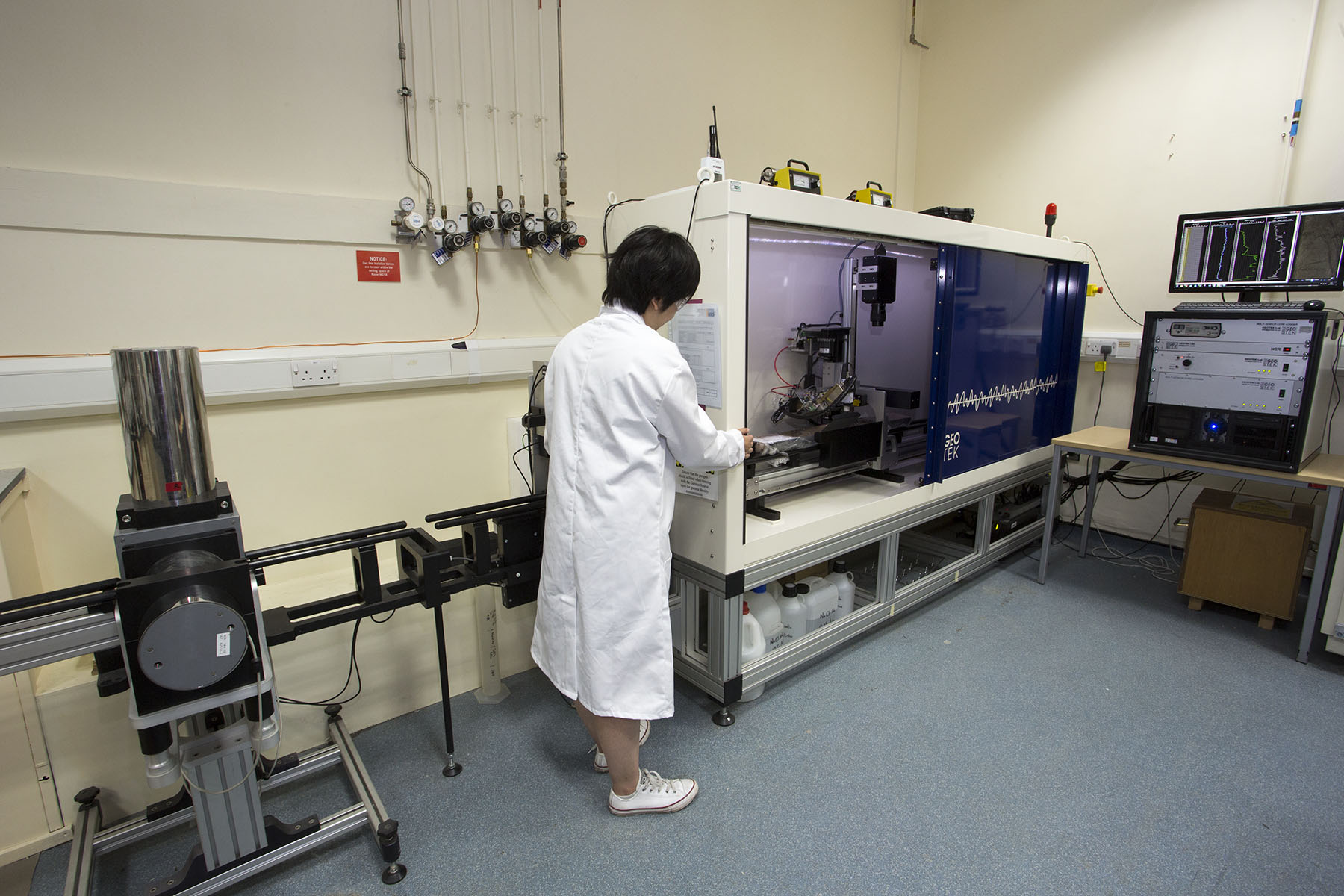
Geotek X-ray CT Core Imaging System (MSCL-XCT)
The Geotek X-ray CT core imaging system is used to collect linear digital x-ray images on whole or split cores. These images are then used to produce computed tomographic (CT) reconstructions, visualising three-dimensional structures within cores. This piece of equipment is unique, as it x-rays cores in a vertical configuration and was designed specifically for the Geography Department at Durham University. Core sections up to 1.5 m in length and 12 cm in diameter can be imaged. The x-ray source and detector positions can be adjusted in order to ensure optimal image quality and to accommodate different core diameters. The system is fully shielded and enclosed, with an interlock system that ensures that x-rays cannot be generated when the doors are open.
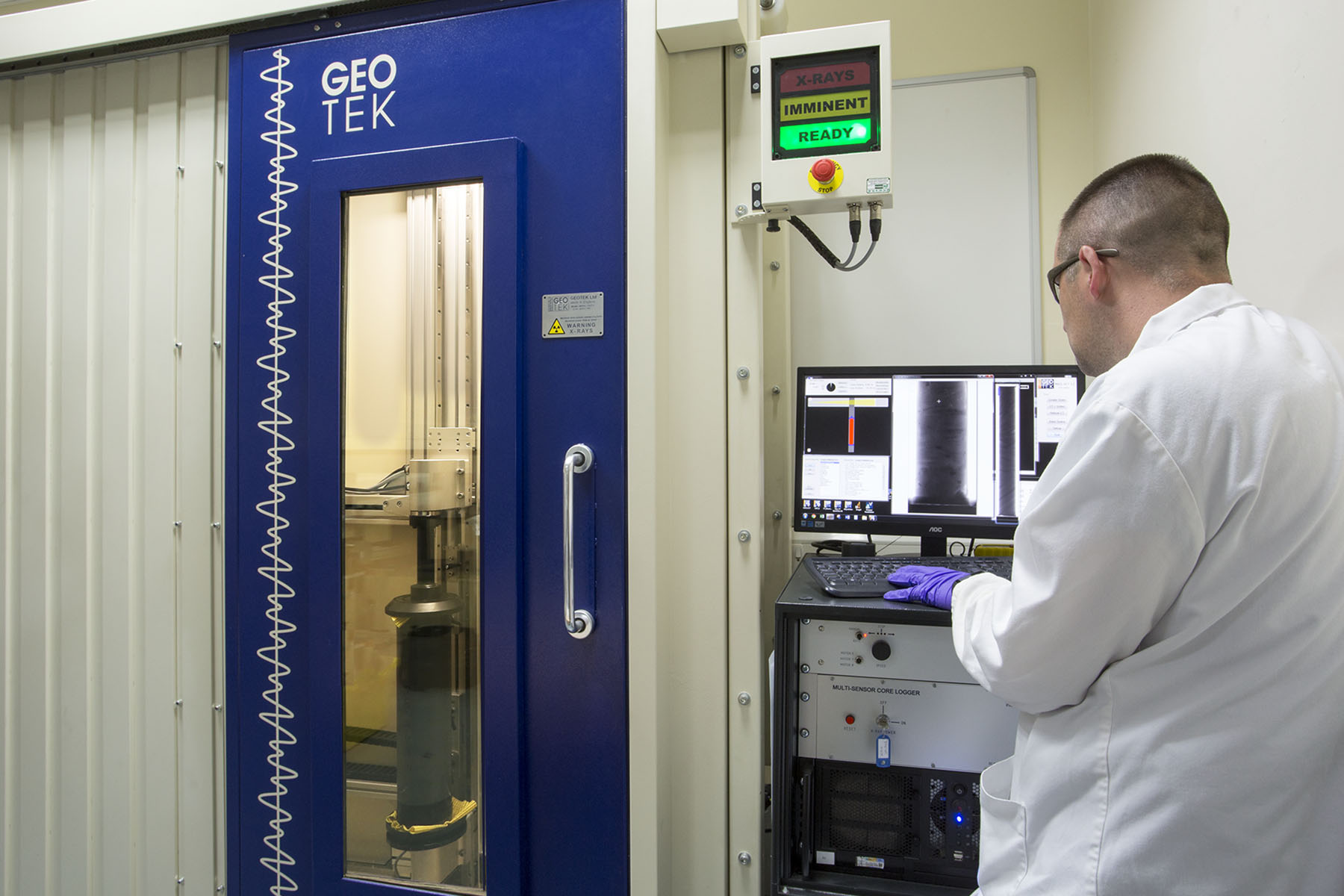
Geotek X-ray Fluorescence (MSCL-XRF)
This instrument is an integrated part of our Multi Sensor Core Logger (MSCL-S) and is used to acquire high-resolution elemental abundance data from the surface of rock cores, sediment cores and sediment slabs. It has a downcore resolution of 0.1 to 10mm and a crosscore resolution of 5, 10 or 15 mm. The sample material is excited by the bombardment of high energy x-rays generated in the rhodium x-ray tube. A wide range of elements (magnesium to uranium) can be detected at ppm levels. To improve the sensitivity of light element (e.g. magnesium, aluminium and silicon) measurements the measurement cell is flushed with helium. The system is fully shielded and enclosed, with an interlock system that ensures that x-rays cannot be generated when the doors are open.
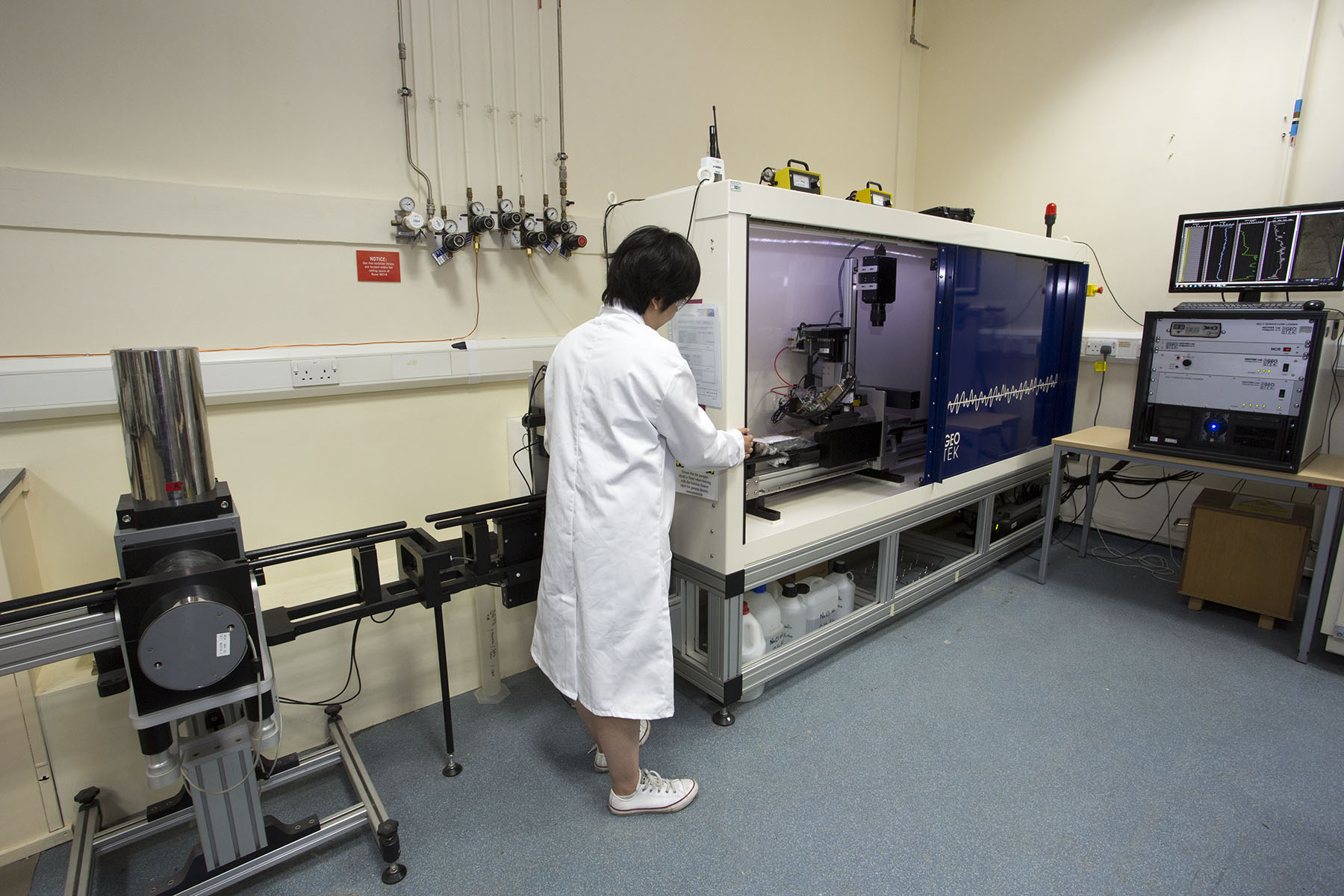
Geotek core splitter
The Geotek core splitter is used to split soft sediment cores contained within plastic core liners. Core samples can be up to 1.5 m long and between 40 and 150 mm in diameter.
Specialised Sample Preparation Equipment
Buchi R-114 Rotorevaporator
This instrument is used to efficiently and gently evaporate volatile solvents from samples. It is used extensively in biomarker sample preparation in our laboratories.
A vacuum pump lowers the pressure in the sample flask, which lowers the boiling point of solvents. Solvents can then be removed from the samples without heat damage occurring.

Christ Alpha 1-4 LSC and 2-4 LSC Freeze Driers
We have two freeze-driers in the Geography laboratories. These are regularly used to prepare samples for chemical analyses. Often samples are ball-milled following freeze-drying. Freeze-drying is routinely selected over oven drying in order to preserve thermally sensitive materials in samples.
Prior to freeze-drying, samples are placed in a -80°C freezer overnight. Samples are then quickly transferred to the freeze-drier where the surrounding pressure is reduced, allowing frozen water in the material to sublimate to the gas phase, bypassing the liquid phase.
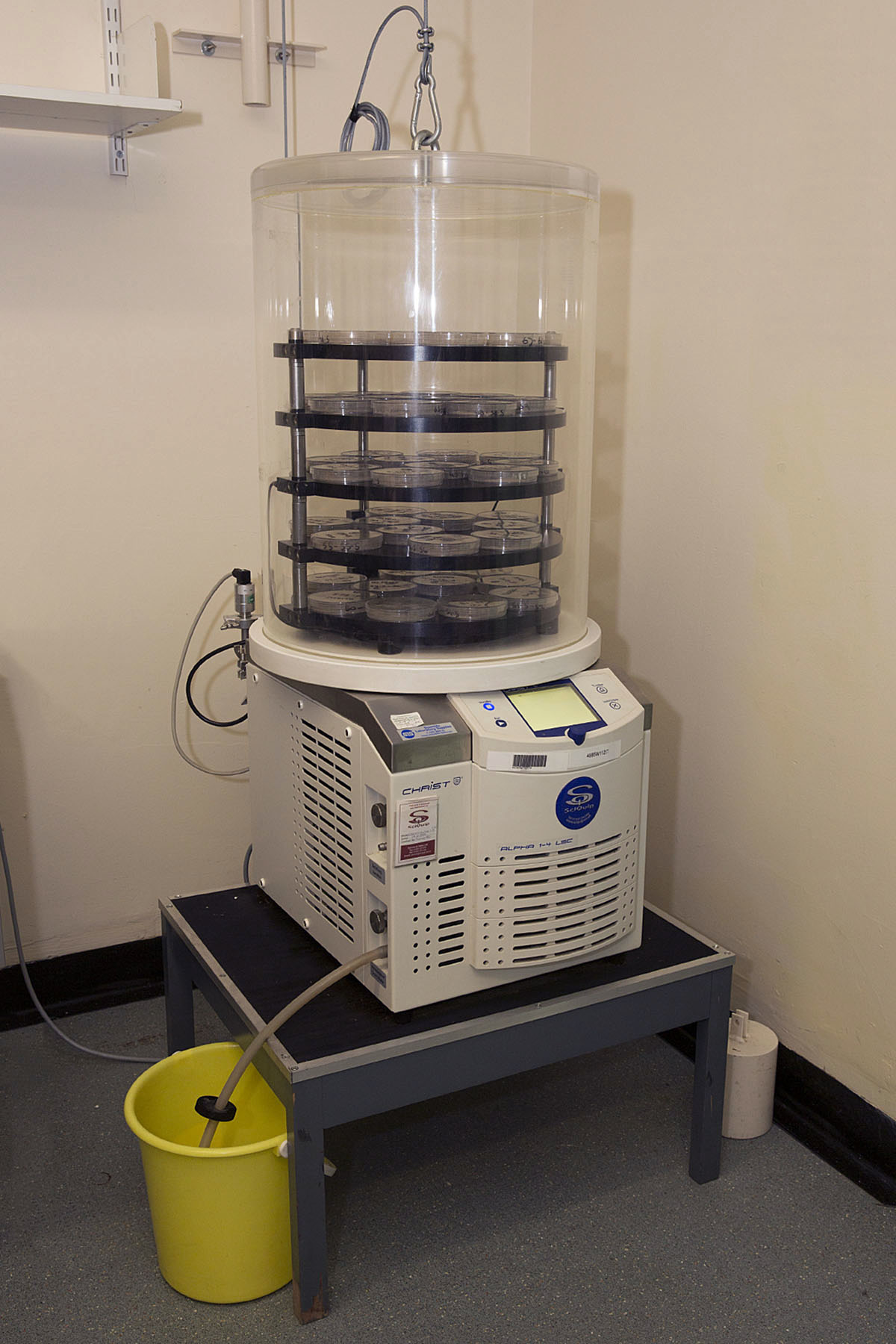
We have two CEM Mars microwaves in our laboratories which are used for acid digestion and solvent extraction. These microwaves are programmable and we routinely employ U.S EPA (Environment Protection Agency) methods.
Samples for acid digestion are weighed into Teflon vessels and concentrated acids are added. The vessels are sealed with Teflon lids and are subjected to microwave irradiation (decreasing the time taken to carry out the digestion due to an increase in temperature and pressure). These samples are most often analysed on our Inductively Coupled Plasma Optical Emission Spectrometer (ICP-OES).
Microwave solvent extraction is used extensively in biomarker sample preparation in our laboratories. Samples for solvent extraction are weighed into Teflon vessels and solvent is added. The vessels are then sealed with Teflon lids and are subjected to microwave irradiation. This technique uses significantly less solvent and is much faster than other methods. These samples are most often analysed on our Gas Chromatograph Flame Ionisation Detector (GC-FID) and Gas Chromatography Mass Spectrometer (GC-MS).
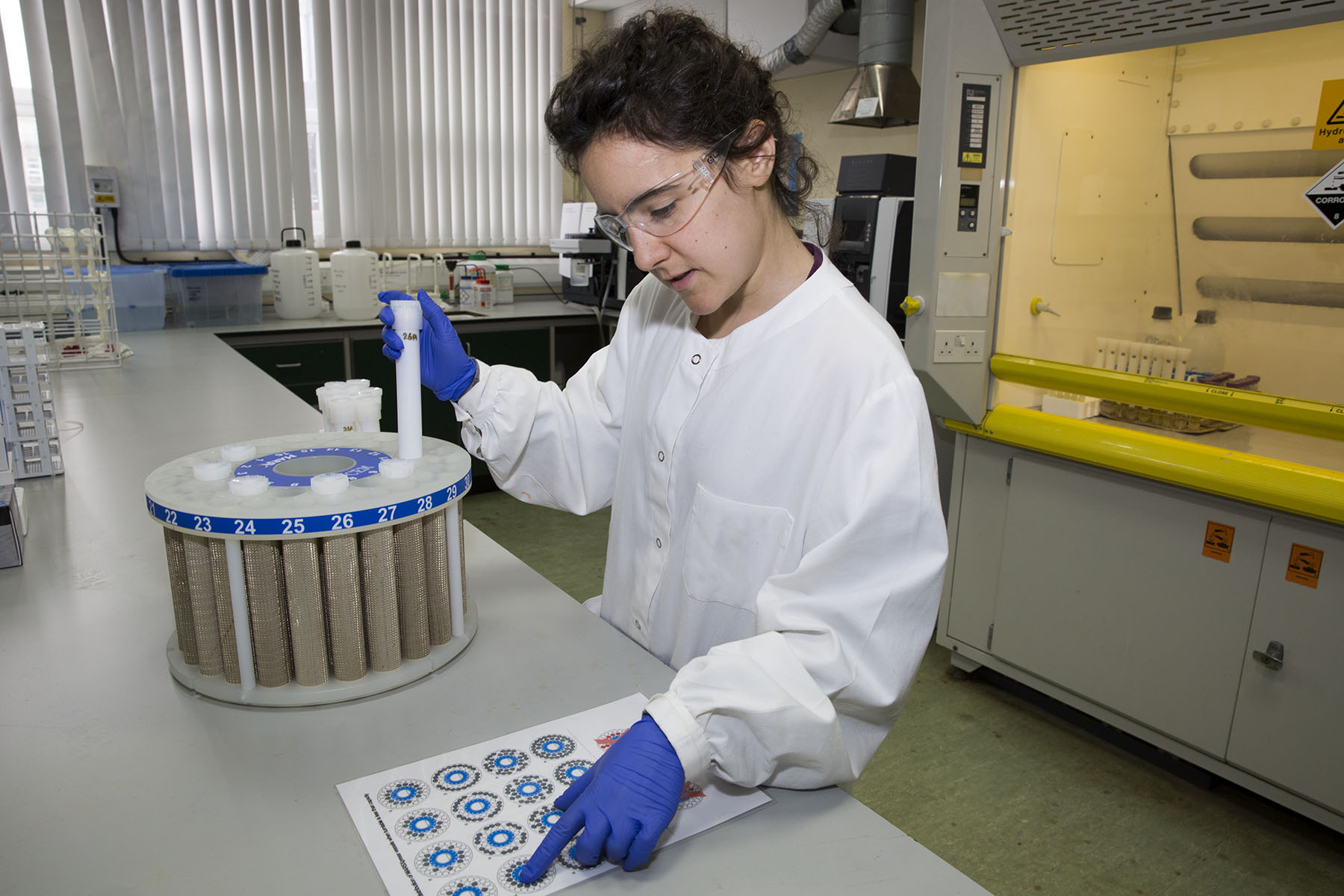
Fritsch Pulverisette 6 Planetary Ball Mills
In the Geography laboratories we have three planetary ball mills which are used to quickly reduce the particle size of freeze-dried or oven-dried samples (e.g. sediment, plant material), without the loss of material. Samples are frequently prepared on this piece of equipment prior to chemical analyses (e.g. element determination, biomarker analysis).
The sample and agate balls are placed in an agate grinding bowl, which rotates around its own axis on a disk, whilst rotating in the opposite direction at up to 650 rpm (revolutions per minute). Sample comminution occurs through the high-energy impact of grinding balls. Two samples can be ball-milled at the same time on each piece of equipment.
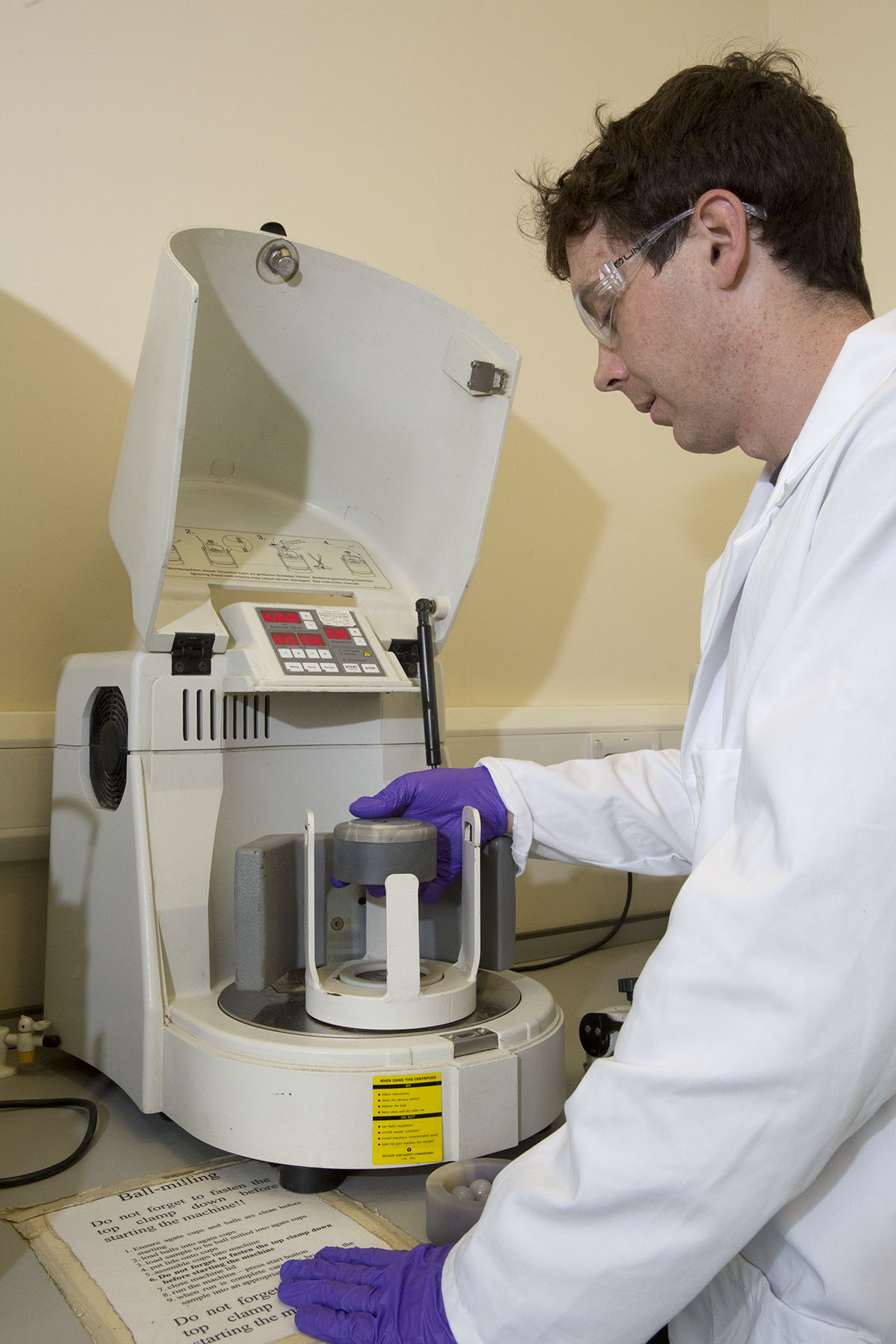
Fume Cupboards
We have seven fume cupboards in the Geography Laboratories. All of these are suitable for Hydrofluoric acid work as they all have water curtains and scrubber systems.

GeneVac EZ-Envi Centrifugal Evaporator
This instrument is used to efficiently and gently evaporate volatile solvents from multiple samples. It is used extensively in biomarker sample preparation in our laboratories.
A vacuum pump lowers the pressure in the sample chamber, which lowers the boiling point of solvents. Solvents can then be removed from the samples without heat damage occurring. The centrifugal force generates a pressure gradient within the solvent, boiling the solvents from the top down.
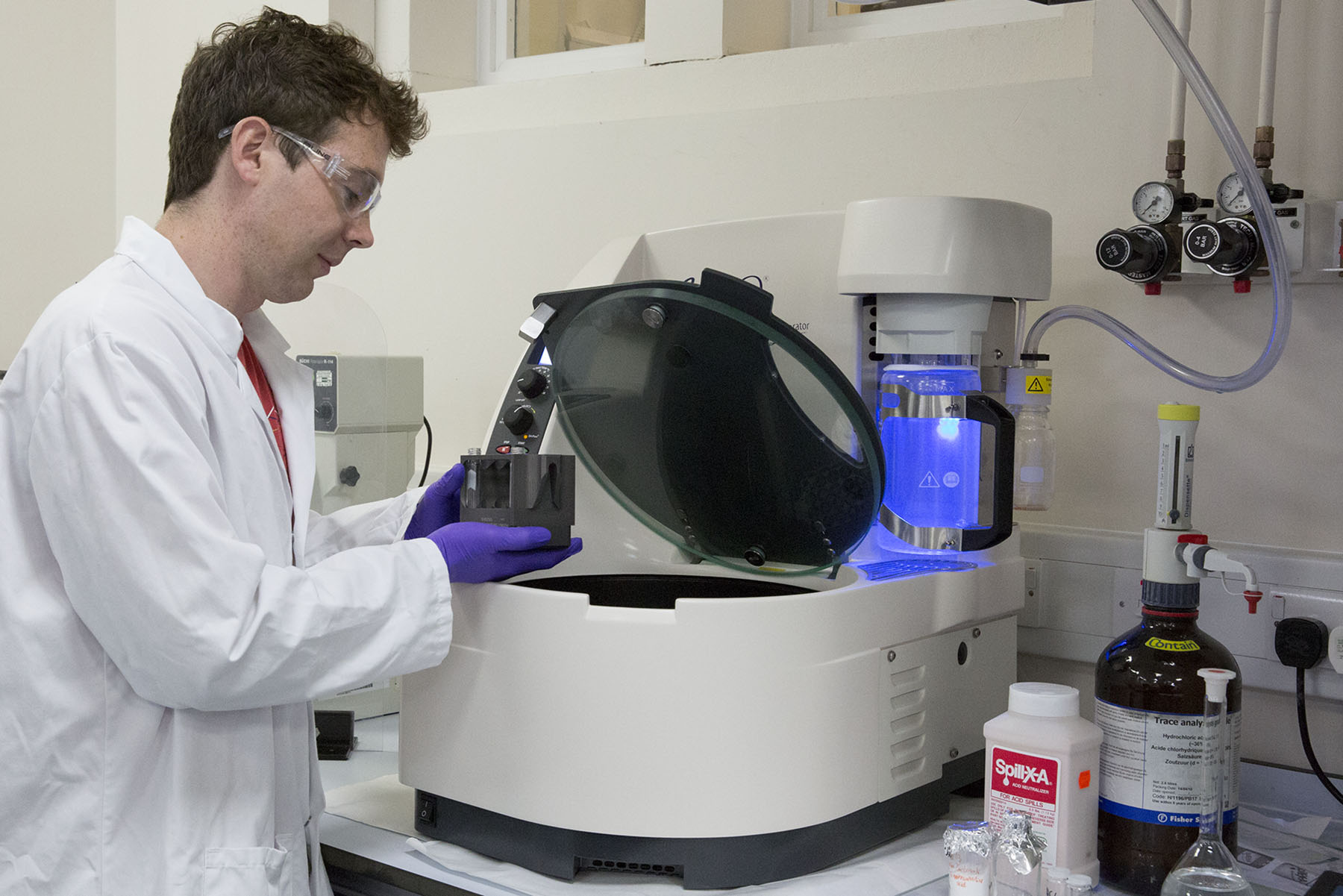
SCP Science DigiPREP LS Digestion System
The DigiPREP LS digestion system is a fully automated Teflon coated graphite heating block. It is used regularly in our laboratories to digest sediment or plant material samples in strong mineral acids (e.g. aqua regia) prior to elemental analysis on instruments such as the Inductively Coupled Plasma Optical Emission Spectrometer (ICP-OES). The system is programmable, ensuring efficient and accurate digestion of samples. The block has a sample capacity of 72, allowing for a high throughput of samples, and a maximum operating temperature of 180°C. We routinely employ an adaptation of U.S EPA (Environment Protection Agency) method EPA3050B when digesting samples using this system.
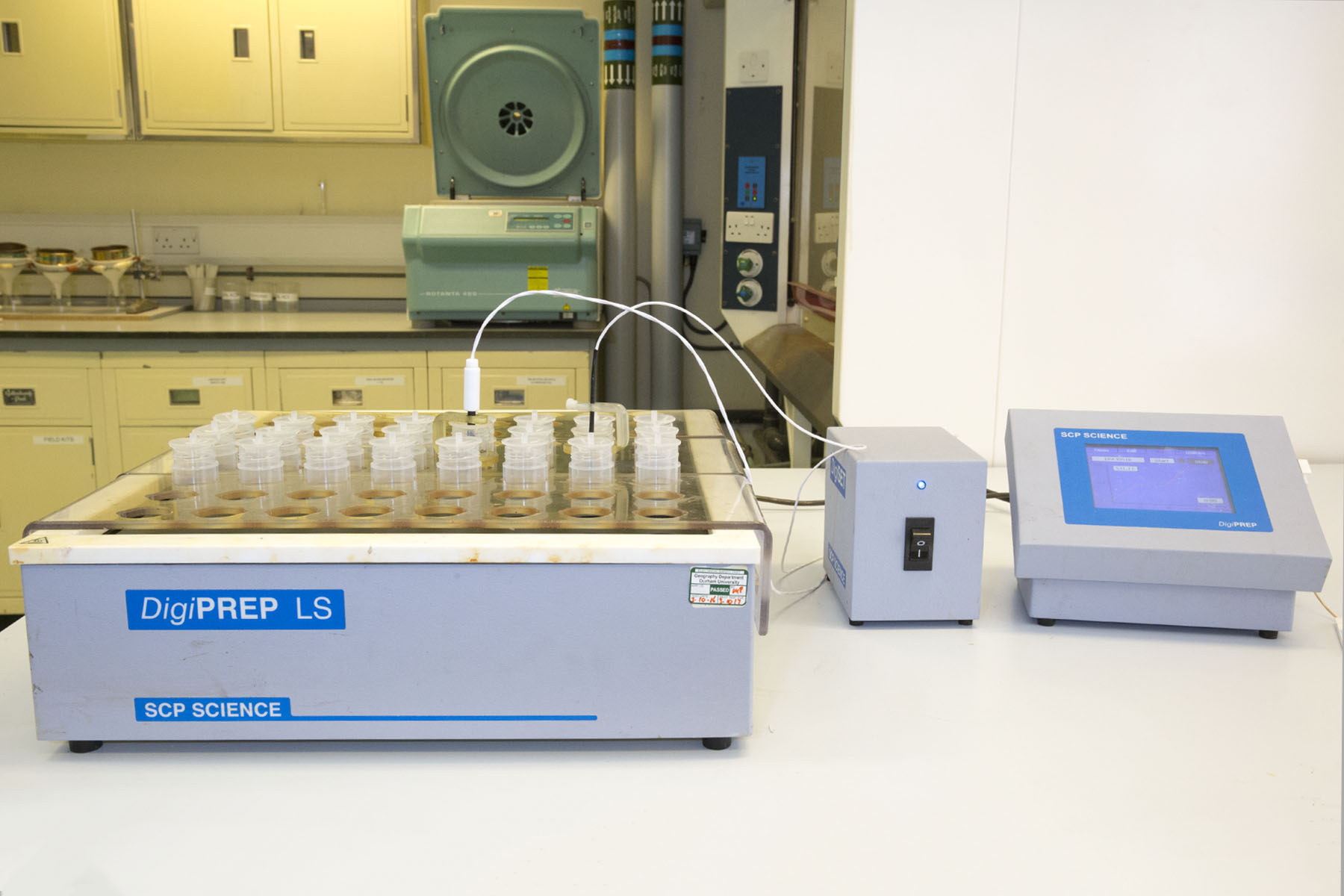


/prod01/prodbucket01/media/durham-university/departments-/geography/Matt_Couchmann-3872X1296.JPG)